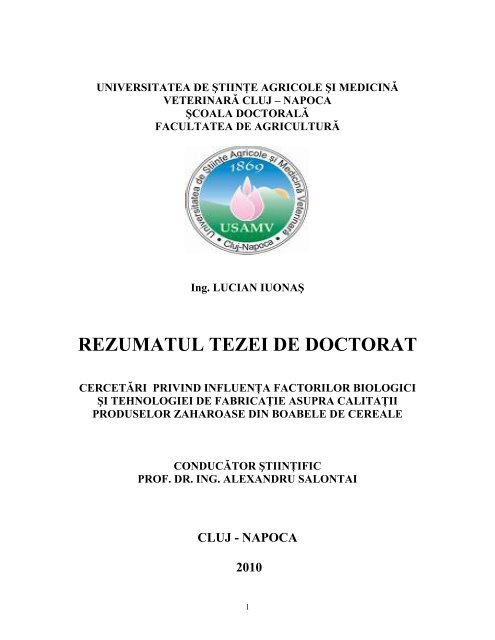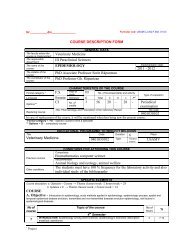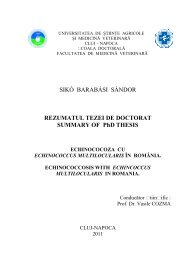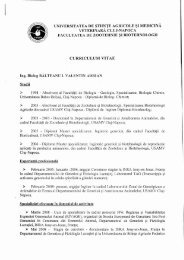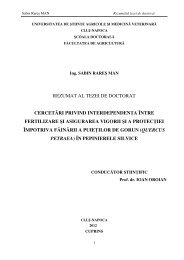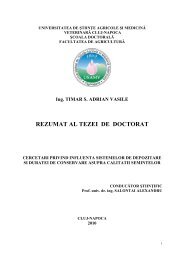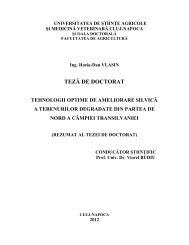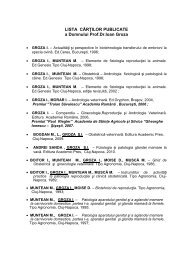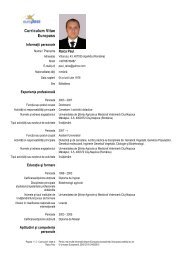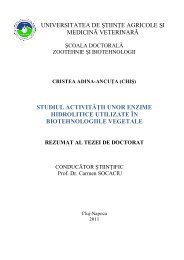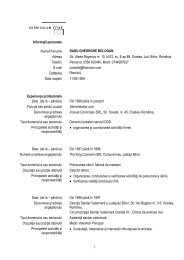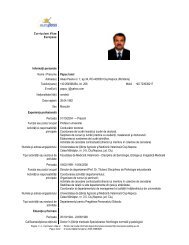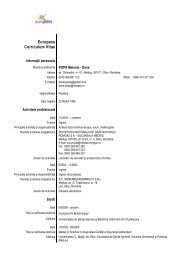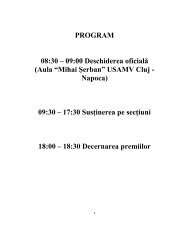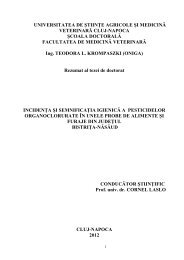rezumatul tezei de doctorat - USAMV Cluj-Napoca
rezumatul tezei de doctorat - USAMV Cluj-Napoca
rezumatul tezei de doctorat - USAMV Cluj-Napoca
Create successful ePaper yourself
Turn your PDF publications into a flip-book with our unique Google optimized e-Paper software.
UNIVERSITATEA DE ŞTIINŢE AGRICOLE ŞI MEDICINĂ<br />
VETERINARĂ CLUJ – NAPOCA<br />
ŞCOALA DOCTORALĂ<br />
FACULTATEA DE AGRICULTURĂ<br />
Ing. LUCIAN IUONAŞ<br />
REZUMATUL TEZEI DE DOCTORAT<br />
CERCETĂRI PRIVIND INFLUENŢA FACTORILOR BIOLOGICI<br />
ŞI TEHNOLOGIEI DE FABRICAŢIE ASUPRA CALITAŢII<br />
PRODUSELOR ZAHAROASE DIN BOABELE DE CEREALE<br />
CONDUCĂTOR ŞTIINŢIFIC<br />
PROF. DR. ING. ALEXANDRU SALONTAI<br />
CLUJ - NAPOCA<br />
2010<br />
1
CUPRINS<br />
INTRODUCERE……………......……………………………..…...............4<br />
CAPITOLUL I. BOABELE DE CEREALE, SURSĂ PRINCIPALĂ DE<br />
MATERII PRIME PENTRU INDUSTRIA PRODUSELOR<br />
ZAHAROASE...............................................................................................5<br />
1.1. BOBELE DE CEREALE, SURSĂ DE SUBSTANŢE ORGANICE....6<br />
1.2. BOABELE DE CEREALE SURSĂ DE SUBSTANŢE MINERALE..6<br />
CAPITOLUL II. CUNOŞTINŢE ACTUALE PRIVIND FABRICAREA<br />
FULGILOR DE CEREALE ŞI BATOANELOR ÎN INDUSTRIA<br />
ALIMENTARĂ ............................................................................................7<br />
2.1. ISTORICUL FABRICĂRII FULGILOR ŞI BATOANELOR ÎN<br />
INDUSTRIA ALIMENTARĂ PE PLAN MONDIAL………………………7<br />
2.2. ISTORICUL FABRICĂRII FULGILOR ŞI BATOANELOR ÎN<br />
INDUSTRIA ALIMENTARĂ ÎN ROMÂNIA………..................................7<br />
2.3. OBIECTIVELE CERCETĂRILOR PROPRII ......................................8<br />
CAPITOLUL III. MATERIALE UTILIZATE ŞI METODICA<br />
EXPERIMENTALĂ....................................................................................8<br />
3.1. MATERIALUL BIOLOGIC ŞI METODICA EXPERIMENTALĂ......8<br />
3.2. ADITIVI UTILIZAŢI ÎN FABRICAREA FULGILOR ŞI<br />
BATOANELOR DE CEREALE ..................................................................-<br />
3.3. UILAJE FOLOSITE ŞI FLUXUL TEHNOLOGIC...............................11<br />
CAPITOLUL IV. REZULTATE ŞI DISCUŢII.......................................14<br />
4.1. REZULTATELE CERCETĂRILOR PENTRU OBŢINEREA<br />
FULGILOR DE GRÂU..................................................................................14<br />
4.2. REZULTATELE CERCETĂRILOR PENTRU OBŢINEREA<br />
FULGILOR DE PORUMB ............................................................................25<br />
2
4.3. REZULTATELE CERCETĂRILOR PENTRU OBŢINEREA<br />
BATOANELOR CU ADAOS DE FULGI DE GRÂU ŞI DE PORUMB..............36<br />
CAPITOLUL V. EFICIENŢA ECONOMICĂ A VARIANTELOR DE<br />
FABRICAŢIE A BATOANELOR CU ADAOS DE FULGI DE GRÂU<br />
ŞI DE PORUMB.........................................................................................39<br />
5.1. EFICIENŢA ECONOMICĂ A VARIANTELOR DE FABRICAŢIE A<br />
BATOANELOR CU ADAOS DE FULGI DE GRÂU..........................39<br />
5.2. EFICIENŢA ECONOMICĂ A VARIANTELOR DE FABRICAŢIE A<br />
BATOANELOR CU ADAOS DE FULGI DE PORUMB………. .......41<br />
CAPITOLUL VI. CONCLUZII GENERALE ŞI RECOMANDĂRI...43<br />
6.1. CONCLUZII PRIVIND FABRICAREA FULGILOR DE GRÂU ŞI DE<br />
PORUMB…………………………………………………………….....43<br />
6.2. CONCLUZII PRIVIND FABRICAREA BATOANELOR CU ADAOS<br />
DE FULGI DE GRÂU ŞI PORUMB……......………………….............44<br />
6.3. RECOMANDĂRI………………………………...……….…...…………..44<br />
BIBLIOGRAFIE SELECTIVĂ<br />
3
INTRODUCERE<br />
Extrudarea în industria alimentară reprezintă un proces <strong>de</strong> plastifiere sub<br />
presiune a unor materii prime şi presarea lor printr-o duză. Pentru extrudare, se<br />
pretează în primul rând materii prime <strong>de</strong> origine vegetală, cu precă<strong>de</strong>re produse <strong>de</strong><br />
măciniş, precum grişul <strong>de</strong> grâu şi porumb, făinuri <strong>de</strong> grâu, orez şi secară.La<br />
acestea se adaugă leguminoasele, cartofi, produse proteice (gluten <strong>de</strong> grâu, şroturi<br />
<strong>de</strong> oleaginoase), singure sau în amestec cu alte materii prime sau cu aditivi (zahăr,<br />
sare, condimente, emulgatori) pentru ameliorarea însuşirilor senzoriale.<br />
( IOANCEA, L şi KATHERINE I., 1988).<br />
În cercetările noastre ne-am propus studierea comparativă a influenţei<br />
genotipului <strong>de</strong> cereale în corelare cu factorii tehnologici <strong>de</strong> fabricaţie asupra<br />
calităţii extrudatelor, în scopul extin<strong>de</strong>rii bazei <strong>de</strong> materii prime pentru fabricarea<br />
fulgilor <strong>de</strong> grâu şi porumb şi valorificarea lor optimă în procesul <strong>de</strong> obţinere a<br />
batoanelor.<br />
Într-un volum <strong>de</strong> 183 pagini, teza <strong>de</strong> <strong>doctorat</strong> este structurată în şase<br />
capitole care includ 138 tabele, 6 grafice şi 39 figuri grupate în două părţi<br />
principale.<br />
Partea generală, care tratează cunoştiinţele actuale, istoricul şi tehnologia<br />
generală <strong>de</strong> fabricare a fulgilor <strong>de</strong> cereale , boabele <strong>de</strong> cereale sursă <strong>de</strong> materii<br />
prime şi obiectivele cercetărilor proprii.( Cap.I.-II ).<br />
Partea <strong>de</strong> cercetări proprii este structurată în patru capitole cuprinzând<br />
materialul biologic, aditivii şi utilajele utilizate în fabricarea fulgilor şi batoanelor<br />
<strong>de</strong> cereale, metoda experimentală (III), rezultate şi discuţii privind cercetările<br />
proprii (IV), eficienţa economică a variantelor <strong>de</strong> fabricaţie a batoanelor cu adaos<br />
<strong>de</strong> fulgii <strong>de</strong> grâu şi porumb (V) şi concluzii generale şi recomandări. (VI).<br />
Orientarea şi conţinutul prezentei teze <strong>de</strong> <strong>doctorat</strong> a fost realizat sub<br />
îndrumarea distinsului profesor Dr.Alexandru Salontai, căruia doresc să-i adresez<br />
pe această cale cele mai sincere mulţumiri şi recunostinţa mea, pentru îndrumarea<br />
4
stiinţifică facută cu înaltă competenţă profesională, pentru sprijinul permanent<br />
acordat, sfaturile şi sugestiile acordate cu multă generozitate<br />
Adresez pe aceasta cale mulţumiri conducerii Universitaţii <strong>de</strong> Ştiinţe<br />
Agricole şi Medicină Veterinară <strong>Cluj</strong> – <strong>Napoca</strong> şi ale Facultaţii <strong>de</strong> Agricultură<br />
pentru sprijinul acordat în realizarea <strong>tezei</strong> <strong>de</strong> <strong>doctorat</strong>.<br />
Deasemenea adresez mulţumiri conducerii S.C.D.A. Turda care cu<br />
generozitate mi-a asigurat materialul biologic necesar experienţelor precum şi<br />
conducerii S.C. Perffettti Van Melle România pentru sprijinul acordat la<br />
efectuarea experienţelor şi înregistrarea datelor experimentale.Aduc mulţumiri<br />
familie mele, pentru sprijinul permanent şi încurajările primite pe tot parcursul<br />
realizarii acestei teze <strong>de</strong> <strong>doctorat</strong>.<br />
CAPITOLUL I. BOABELE DE CEREALE, SURSĂ PRINCIPALĂ DE<br />
MATERII PRIME PENTRU INDUSTRIA PRODUSELOR<br />
ZAHAROASE<br />
Într-o clasificare a principalelor grupe <strong>de</strong> alimente, după GONŢEA<br />
I.(1970), cerealele şi <strong>de</strong>rivatele lor fac parte din grupa VI-a reprezentînd sursa cea<br />
mai importantă <strong>de</strong> energie datorită aportului mare în alimentaţie cu o valoare<br />
calorică ridicată. Valoarea nutritivă a boabelor <strong>de</strong> cereale este <strong>de</strong>terminată <strong>de</strong><br />
compoziţia chimică a acestora, care după BILTEANU, GH. şi colab.( 1991 )<br />
inclu<strong>de</strong> :57 – 75,1 % substanţe neazotoase, 7,7 – 24 % substanţe proteice, 1,5 – 4,1<br />
% grăsimi, 1,9 – 4,85 % celuloză şi 0,5 – 2,78 % substanţe minerale.Raportul<br />
dintre aceste componente chimice este apreciat ca fiind foarte echilibrat pentru o<br />
nutriţie raţională omului, în<strong>de</strong>osebi în cazul grâului şi porumbului, principalele<br />
cereale consumate pe glob şi în ţara noastră.<br />
5
1.1. BOBELE DE CEREALE, SURSĂ DE SUBSTANŢE ORGANICE<br />
Deşi boabele <strong>de</strong> cereale au un conţinut relativ scăzut <strong>de</strong> proteine, ţinând<br />
seama <strong>de</strong> faptul că ele sunt larg utilizate în alimentaţie, reprezintă cea mai<br />
importantă sursă proteică a omenirii, ele furnizând aproximativ jumatate din<br />
proteinele consumate <strong>de</strong> om. Proteinele alimentare, prin procesul <strong>de</strong> digestie,<br />
eliberează aminoacizii care constituie sursa principală din care organismul se<br />
alimentează. Proteinele intervin în creşterea celulară, în constituţia enzimelor,<br />
controlează numeroase procese metabolice şi participă larg la formarea <strong>de</strong><br />
anticorpi.( SEGAL,B, şi colab.1982 ).<br />
Substanţele neazotoase se găsesc în pon<strong>de</strong>re mare în endospermul boabelor<br />
<strong>de</strong> cereale şi sunt compuse din amidon, circa 90 %, zahăr 2-3,5 % şi <strong>de</strong>xtrină 2,3<br />
%.Substanţele grase în boabele <strong>de</strong> cereale se găsesc în proporţie <strong>de</strong> 1,5 – 6 % cu<br />
pon<strong>de</strong>re mai mare în embrion, care la porumb sunt în proporţie <strong>de</strong> 30 – 35 % iar la<br />
grâu <strong>de</strong> numai 1,5 %. La porumb din conţinutul total <strong>de</strong> grăsimi, în embrion se află<br />
83,2 % şi circa 15 % în endosperm.( SALONTAI, AL., MUNTEAN, L. 1982 ).<br />
Cerealele conţin vitaminele: B1, B2, B6, E, D, şi PP. Embrionul, <strong>de</strong>şi este <strong>de</strong><br />
dimensiuni mici conţine 50 % din tiamină ( B1 ) , şi 30 % din niacină ( PP ).<br />
(SEGAL, B şi colab.1982). Stratul aleuronic şi celelalte învelişuri exterioare<br />
conţin 50 % din niacină şi 35 % din riboflavină ( B2 ). Endospermul care este<br />
partea prepon<strong>de</strong>rentă a bobului conţine 1/3 sau chiar mai puţin din cantitatea <strong>de</strong><br />
vitamina B. În formă uscată boabele <strong>de</strong> cereale sunt lipsite <strong>de</strong> vitamina C; cu<br />
excepţia porumbului galben, ele sunt lipsite şi <strong>de</strong> caroten.( provitamina A ).<br />
( SEGAL, B si colab.1982 ).<br />
1.2. BOABELE DE CEREALE SURSĂ DE SUBSTANŢE MINERALE<br />
Boabele <strong>de</strong> cereale conţin între 1,4 – 3 % substanţe minerale ( K, P, Mg ),<br />
concentrate în cea mai mare masură în învelişul boabelor, substanţe care se<br />
în<strong>de</strong>părtează prin prelucrarea ulterioară a cerealelor.<br />
6
CAPITOLUL II. CUNOŞTINŢE ACTUALE PRIVIND<br />
FABRICAREA FULGILOR DE CEREALE ŞI BATOANELOR ÎN<br />
INDUSTRIA ALIMENTARĂ<br />
2.1. ISTORICUL FABRICĂRII FULGILOR ŞI BATOANELOR ÎN<br />
INDUSTRIA ALIMENTARĂ PE PLAN MONDIAL<br />
Industria fulgilor <strong>de</strong> cereale este reprezentată din firme care sunt angajate în<br />
fabricarea şi vânzarea produselor alimentare preambalate făcute în principal din<br />
cereale. Consumatorul nu trebuie să prepare produsul înainte <strong>de</strong> a-l folosi şi poate<br />
fi consumat sub formă uscată sau prin adăugarea unor produse alimentare cum am<br />
fi laptele, iaurtul. Printre avantajele fulgilor, din perspectiva consumatorului se<br />
numără uşurinţa în folosirea lor pentru satisfacerea nevoilor <strong>de</strong> hrană. Consumarea<br />
produsului are loc în principal la micul <strong>de</strong>jun, dar sunt <strong>de</strong> asemenea folosite şi ca<br />
gustări.<br />
Industria fulgilor <strong>de</strong> cereale are o cifră <strong>de</strong> afaceri <strong>de</strong> 4 miliar<strong>de</strong> $ şi este<br />
compusă din câteva companii mari care domină piaţa. Condusă <strong>de</strong> Kellogg,<br />
industria fulgilor inclu<strong>de</strong> General Mills, General Foods, Quaker Oats, Ralston<br />
Purina şi Nabisco.<br />
2.2. ISTORICUL FABRICĂRII FULGILOR ŞI BATOANELOR ÎN INDUSTRIA<br />
ALIMENTARĂ ÎN ROMÂNIA<br />
În ţara noastră extrudarea este în fază <strong>de</strong> cercetare, cu excepţia producerii<br />
<strong>de</strong> amidonuri modificate pentru foraje petroliere. Pentru industria alimentară la noi<br />
în ţară s-au realizat extru<strong>de</strong>rele SOTEX 135, conform documentaţiei elaborate <strong>de</strong><br />
catre ICPIAF <strong>Cluj</strong>-<strong>Napoca</strong> şi extru<strong>de</strong>rul granulator tip 15X60 EG-1, produs <strong>de</strong><br />
CCSITMUIU-Bucureşti. ( IOANCEA, L şi KATHERINE I., 1988).<br />
Înainte <strong>de</strong> anul 1989, în România existau doar două fabrici producatoare <strong>de</strong><br />
fulgi <strong>de</strong> cereale: Titan S.A. Bucureşti şi Dobrogea Constanţa. În <strong>Cluj</strong>, la fabrica<br />
Feleacul, producţia <strong>de</strong> ,,pufarin”, cereale obţinute prin expandarea arpacaşului <strong>de</strong><br />
7
grâu şi porumb în tunuri <strong>de</strong> expandare şi drajate cu sirop <strong>de</strong> zahar erau singurele<br />
produse <strong>de</strong> acest gen pe piaţa românească.<br />
2.3. OBIECTIVELE CERCETĂRILOR PROPRII<br />
În Romănia lipsesc cercetările ştiinţifice privind extrudarea cerealelor, fapt<br />
pentru care s-au consi<strong>de</strong>rat oportune investigaţiile noastre, în acest sens cu<br />
următoarele obiective:<br />
• extin<strong>de</strong>rea bazei <strong>de</strong> materii prime pentru extrudare;<br />
• stabilirea influenţei genotipului <strong>de</strong> cereale asupra calitaţii extrudatelor<br />
şi stabilirea factorilor tehnologici optimi;<br />
• stabilirea influenţei duratei <strong>de</strong> <strong>de</strong>pozitare asupra calitaţii extrudatelor<br />
• valorificarea superioară a cerealelor extrudate sub formă <strong>de</strong> produse<br />
zaharoase;<br />
• posibilitaţi <strong>de</strong> diversificare a produselor zaharoase extrudate din<br />
cereale.<br />
CAPITOLUL III. MATERIALE UTILIZATE ŞI METODICA<br />
EXPERIMENTALĂ<br />
3.1.MATERIALUL BIOLOGIC ŞI METODICA EXPERIMENTALĂ<br />
Pentru realizarea obiectivelor propuse au fost luate în studiu boabele<br />
aparţinătoare a două dintre principalele cereale, grâul Triticum aestivum ( L )<br />
ssp.vulgare ( Vill ) respectiv soiurile Turda 95, Arieşan, Turda 2000 şi porumbul,<br />
Zeea mays ( L ), respectiv genotipurile Turda Favorit, Turda 200, Turda Super<br />
omologate şi create la S.C.D.A. Turda.<br />
La efectuarea experimentărilor s-a utilizat un extru<strong>de</strong>r cu două şnecuri <strong>de</strong><br />
tipul CLEXTRAL BC – 21, <strong>de</strong> capacitate 12,1 kg / oră, cu diametrul şnecului <strong>de</strong><br />
25 mm şi cu diametrul ajutajului matriţei <strong>de</strong> 3 mm. Au fost luate în studiu<br />
următorii factori şi graduări:<br />
8
Pentru obţinerea fulgilor <strong>de</strong> grâu:<br />
Factorul A = genotipul ( soiul ) cu graduările:<br />
a1 = Turda 95; a2 = Turda 2000; a3 = Arieşan;<br />
Factorul B = umiditatea amestecului ( % ) cu graduările:<br />
b1 = 21; b2 = 23; b3 = 25;<br />
Factorul C = <strong>de</strong>bitul <strong>de</strong> alimentare ( kg / oră ) cu graduările:<br />
c1 = 3,5; c2 = 5,4; c3 = 7,2.<br />
Pentru obtinerea fulgilor <strong>de</strong> porumb:<br />
Factorul A = genotipul ( hibridul ) <strong>de</strong> porumb cu graduările:<br />
a1 = Turda Favorit; a2 = Turda 200; a3 = Turda Super;<br />
Factorul B = umiditatea amestecului ( % ) cu graduările:<br />
b1 = 21; b2 = 23; b3 = 25;<br />
Factorul C = <strong>de</strong>bitul <strong>de</strong> alimentare ( kg / oră ) cu graduările:<br />
c1 = 3,5; c2 = 5,4; c3 = 7,2.<br />
Factorii B şi C sunt similari cu cei <strong>de</strong> la fulgii <strong>de</strong> grâu.<br />
Din combinaţia factorilor şi a graduărilor, pentru fiecare specie a rezultat o<br />
experienţă trifactorială <strong>de</strong> tipul 3 x 3 x 3, cu 27 variante, după cum urmează:<br />
V1 = a1 b1 c1; V 10 = a2 b1 c1: V 19 = a3 b1 c1;<br />
V2 = a1 b1 c2; V 11 = a2 b1 c2; V 20 = a3 b1 c2;<br />
V3 = a1 b1 c3; V 12 = a2 b1 c3; V 21 = a3 b1 c3;<br />
V4 = a1 b2 c1; V 13 = a2 b2 c1; V 22 = a3 b2 c1;<br />
V5 = a1 b2 c2; V 14 = a2 b2 c2; V 23 = a3 b2 c2;<br />
V6 = a1 b2 c3; V 15 = a2 b2 c3; V 24 = a3 b2 c3:<br />
V7 = a1 b3 c1; V 16 = a2 b3 c1; V 25 = a3 b3 c1:<br />
V8 = a1 b3 c2; V 17 = a2 b3 c2; V 26 = a3 b3 c2:<br />
V9 = a1 b3 c3; V 18 = a2 b3 c3; V 27 = a3 b3 c3:<br />
9
Pentru compararea rezultatelor experimentale s-a luat ca variantă martor<br />
( standard ), media tuturor variantelor ( X ).(SĂULESCU N.,1959). Ca însuşiri<br />
fizice s-au <strong>de</strong>terminat indicele <strong>de</strong> expansiune şi <strong>de</strong>nsitatea în vrac, iar dintre cele<br />
chimice, conţinutul în amidon şi proteină.Toate aceste însuşiri au fost <strong>de</strong>terminate<br />
în trei etape: la <strong>de</strong>pozitare, la şase luni şi la 12 luni.<br />
Indicele <strong>de</strong> expansiune a fost <strong>de</strong>terminat conform meto<strong>de</strong>i lui RAYAS -<br />
DUARTE ( 1988 ), prin măsurarea diametrului a zece extrudate cu un şubler după<br />
care s-a calculat media aritmetică şi s-a divizat cu diametrul ajutajului matriţei.<br />
Masa volumetrică în g / l s-a <strong>de</strong>terminat cu ajutorul unei balanţe hectolitrice<br />
cu capacitate <strong>de</strong> 1 litru, conţinutul <strong>de</strong> proteine s-a efectuat dupa metoda Kjeldahl,<br />
iar amidonul prin metoda Evers.<br />
Pentru obţinerea batoanelor cu fulgi <strong>de</strong> grâu s-a utilizat soiul <strong>de</strong> grâu<br />
Turda 95, iar pentru batoanele cu fulgi <strong>de</strong> porumb hibridul Turda Favorit, cu<br />
conţinutul diferit <strong>de</strong> fulgi 5%, 6%, 7%, 8% şi 9% rezultând câte o experienţă<br />
monofactorială Tabelele 3.1.şi 3. 2.<br />
Nr.<br />
Crt<br />
.<br />
Tabelul 3.1.<br />
Variante <strong>de</strong> produse luate în studiu la fabricarea batoanelor cu fulgi <strong>de</strong> grâu<br />
Variante<br />
( % fulgi<br />
<strong>de</strong> grâu )<br />
U.M<br />
.<br />
Fondant<br />
Acofect<br />
Lapte<br />
praf<br />
<strong>de</strong>gresat<br />
Materii prime<br />
Cacao<br />
pudră<br />
Lecitină<br />
<strong>de</strong> soia<br />
Aromă<br />
<strong>de</strong> rom<br />
Sorbat<br />
<strong>de</strong><br />
potasiu<br />
Sorbitol<br />
Glazura<br />
<strong>de</strong> cacao<br />
1. 5 % Kg 66 4,5 4,0 2,5 0,072 0,2 0,04 0,082 20<br />
2. 6 % Kg 66 4,5 4,0 2,5 0,072 0,2 0,04 0,082 20<br />
3. 7 % Kg 66 4,5 4,0 2,5 0,072 0,2 0,04 0,082 20<br />
4. 8 % Kg 66 4,5 4,0 2,5 0,072 0,2 0,04 0,082 20<br />
5. 9 % Kg 66 4,5 4,0 2,5 0,072 0,2 0,04 0,082 20<br />
10
Nr.<br />
Crt.<br />
Tabelul 3.2.<br />
Variante <strong>de</strong> produse luate în studiu la fabricarea batoanelor cu fulgi <strong>de</strong> porumb<br />
Variante<br />
( % fulgi<br />
<strong>de</strong><br />
porumb)<br />
U.M<br />
.<br />
Fondant<br />
Acofect<br />
Lapte<br />
praf<br />
<strong>de</strong>gresat<br />
Materii prime<br />
Cacao<br />
pudră<br />
Lecitină<br />
<strong>de</strong> soia<br />
Aromă<br />
<strong>de</strong> rom<br />
Sorbat<br />
<strong>de</strong><br />
potasiu<br />
Sorbitol<br />
Glazura<br />
<strong>de</strong> cacao<br />
1. 5 % Kg 66 4,5 4,0 2,5 0,072 0,2 0,04 0,082 20<br />
2. 6 % Kg 66 4,5 4,0 2,5 0,072 0,2 0,04 0,082 20<br />
3. 7 % Kg 66 4,5 4,0 2,5 0,072 0,2 0,04 0,082 20<br />
4. 8 % Kg 66 4,5 4,0 2,5 0,072 0,2 0,04 0,082 20<br />
5. 9 % Kg 66 4,5 4,0 2,5 0,072 0,2 0,04 0,082 20<br />
Experimentările au fost efectuate în cadrul societaţii comerciale S.C.<br />
Perfetti Van Melle Romania, <strong>Cluj</strong> - <strong>Napoca</strong>, utilajele folosite la obţinerea<br />
batoanelor cu adaos <strong>de</strong> cereale fiind următoarele:cazan duplex pentru fierberea<br />
siropului <strong>de</strong> fondant, fondantieră, malaxor , extru<strong>de</strong>r, maşina <strong>de</strong> glazurat şi maşina<br />
<strong>de</strong> ambalat batoane.<br />
Batoanele cu adaos <strong>de</strong> fulgi <strong>de</strong> grâu şi porumb obţinute în urma<br />
experimentărilor au fost analizate prin meto<strong>de</strong> senzoriale cu scări <strong>de</strong> punctaj fiind<br />
efectuate <strong>de</strong> către cinci <strong>de</strong>gustatori, media însuşirilor constituind însuşirea<br />
organoleptică a fiecarei variante.<br />
3.3. UILAJE FOLOSITE ŞI FLUXUL TEHNOLOGIC<br />
În procesul <strong>de</strong> fabricare a fulgilor <strong>de</strong> cereale există mai multe variante <strong>de</strong><br />
linii <strong>de</strong> fabricaţie, cu utilaje specifice în funcţie <strong>de</strong> producător, dar care în final<br />
în<strong>de</strong>plinesc scopul operaţiei pentru care au fost proiectate. Cu tehnologia <strong>de</strong><br />
extrudare pot fi fabricaţi fulgi <strong>de</strong> cereale cu aroma <strong>de</strong>plin <strong>de</strong>zvoltată, textură<br />
crocantă specifică. Combinând diferite cereale este posibilă obţinerea <strong>de</strong> fulgi cu<br />
11
textură şi gust specific şi un mai mare echilibru a compoziţiei nutriţionale.<br />
Sistemul <strong>de</strong> acoperire special, poate utiliza zahăr, miere, cacao pudră. În Figura<br />
3.1.se poate observa o schemă posibilă a liniei <strong>de</strong> fabricaţie pentru producerea<br />
snaksurilor dulci şi a cerealelor pentru micul <strong>de</strong>jun.<br />
Omogenizare<br />
Transport<br />
Umidificator<br />
Figura 3.1. : Schemă posibilă a liniei <strong>de</strong> fabricaţie pentru producerea snaksurilor<br />
dulci şi a cerealelor pentru micul <strong>de</strong>jun. ( După Internet, Profilul companiei<br />
Clextral )<br />
Pentru obţinerea batoanelor cu adaos <strong>de</strong> fulgi <strong>de</strong> cereale au fost utilizate<br />
următoarele utilaje: cazanul duplex pentru fierberea siropului <strong>de</strong> fondant,<br />
fondantieră, malaxor, extru<strong>de</strong>r, maşina <strong>de</strong> glazurat şi maşina <strong>de</strong> ambalat batoane.<br />
Schema tehnologică <strong>de</strong> fabricare a batoanelor cu adaos <strong>de</strong> fulgi <strong>de</strong> cereale<br />
este prezentată în figura 3.2.<br />
Extrudare<br />
12<br />
Uscare<br />
Racire<br />
Arome
Fig. 3.2. Schema tehnologică <strong>de</strong> fabricare a batoanelor cu fulgi <strong>de</strong> cereale<br />
( adaptată după documentaţia Fundy Ungaria )<br />
13
CAPITOLUL IV. REZULTATE ŞI DISCUŢII<br />
4.1. REZULTATELE CERCETĂRILOR PENTRU OBŢINEREA<br />
FULGILOR DE GRÂU<br />
4.1.1.Rezultatele cercetărilor privind influenţa interacţiunii genotipului,<br />
umidităţii şi <strong>de</strong>bitului <strong>de</strong> alimentare asupra indicelui <strong>de</strong> expansiune a fulgilor<br />
<strong>de</strong> grâu.<br />
Indicele <strong>de</strong> expansiune a fulgilor <strong>de</strong> grâu la <strong>de</strong>pozitare, la şase luni şi la 12<br />
luni sub influenţa factorilor luaţi în studiu este prezentat în figurile 4.1, 4.2, 4.3.<br />
4<br />
3,5<br />
3<br />
2,5<br />
2<br />
1,5<br />
1<br />
0,5<br />
0<br />
Indice <strong>de</strong><br />
expansiune( cm )<br />
*** *** *** *** *** *** *** *** 000 *** *** *** 000 *** 000 000 000 000 000 0000000<br />
000 000 000 000 000 000 -<br />
a1<br />
b1<br />
c1<br />
a1<br />
b1<br />
c2<br />
a1<br />
b1<br />
c3<br />
a1<br />
b2<br />
c1<br />
a1<br />
b2<br />
c2<br />
a1<br />
b2<br />
c3<br />
a1<br />
b3<br />
c1<br />
a1<br />
b3<br />
c2<br />
a1<br />
b3<br />
c3<br />
a2<br />
b1<br />
c1<br />
a2<br />
b1<br />
c2<br />
a2<br />
b1<br />
c3<br />
Fig.4.1.Influenţa genotipului, umiditaţii şi a <strong>de</strong>bitului <strong>de</strong> alimentare asupra<br />
indicelui <strong>de</strong> expansiune la fulgii <strong>de</strong> grâu la <strong>de</strong>pozitare<br />
a2<br />
b2<br />
c1<br />
a2<br />
b2<br />
c2<br />
a2<br />
b2<br />
c3<br />
a2<br />
b3<br />
c1<br />
Semnificaţie / Varianta<br />
14<br />
a2<br />
b3<br />
c2<br />
a2<br />
b3<br />
c3<br />
a3<br />
b1<br />
c1<br />
a3<br />
b1<br />
c2<br />
a3<br />
b1<br />
c3<br />
a3<br />
b2<br />
c1<br />
a3<br />
b2<br />
c2<br />
a3<br />
b2<br />
c3<br />
a3<br />
b3<br />
c1<br />
a3<br />
b3<br />
c2<br />
a3 X (<br />
b3 martor<br />
c3 )
4,5<br />
4<br />
3,5<br />
3<br />
2,5<br />
2<br />
1,5<br />
1<br />
0,5<br />
0<br />
4,5<br />
4<br />
3,5<br />
3<br />
2,5<br />
2<br />
1,5<br />
1<br />
0,5<br />
0<br />
Indice <strong>de</strong><br />
expansiune ( cm )<br />
*** *** ** *** ** * - * - - - - - - - 0 - 00 00 - 0 - 0 000 - 000 000<br />
a1<br />
b1<br />
c1<br />
Fig. 4.2.. Influenţa genotipului, umiditatii şi a <strong>de</strong>bitului <strong>de</strong> alimentare asupra<br />
indicelui <strong>de</strong> expansiune la fulgii <strong>de</strong> grâu la şase luni<br />
*** *** *** *** *** *** *** 000 *** *** *** 000 *** 000 000 000 000 000 000 000 000 000 000 000 000 000 000<br />
a1<br />
b1<br />
c1<br />
a1<br />
b1<br />
c2<br />
a1<br />
b1<br />
c2<br />
a1<br />
b1<br />
c3<br />
a1<br />
b1<br />
c3<br />
a1<br />
b2<br />
c1<br />
a1<br />
b2<br />
c1<br />
a1<br />
b2<br />
c2<br />
a1<br />
b2<br />
c2<br />
a1<br />
b2<br />
c3<br />
Indice <strong>de</strong><br />
expansiune ( cm )<br />
a1<br />
b2<br />
c3<br />
a1<br />
b3<br />
c1<br />
a1<br />
b3<br />
c1<br />
a1<br />
b3<br />
c2<br />
a1<br />
b3<br />
c2<br />
a1<br />
b3<br />
c3<br />
a1<br />
b3<br />
c3<br />
a2<br />
b1<br />
c1<br />
a2<br />
b1<br />
c1<br />
a2<br />
b1<br />
c2<br />
a2<br />
b1<br />
c2<br />
a2<br />
b1<br />
c3<br />
a2<br />
b1<br />
c3<br />
a2<br />
b2<br />
c1<br />
a2<br />
b2<br />
c1<br />
a2<br />
b2<br />
c2<br />
a2<br />
b2<br />
c2<br />
Semnificaţie /<br />
l<br />
a2<br />
b2<br />
c3<br />
l<br />
a2<br />
b2<br />
c3<br />
a2<br />
b3<br />
c1<br />
a2<br />
b3<br />
c1<br />
Fig.4.3. Influenţa genotipului, umiditaţii şi a <strong>de</strong>bitului <strong>de</strong> alimentare asupra<br />
indicelui <strong>de</strong> expansiune la fulgii <strong>de</strong> grâu la 12 luni<br />
a2<br />
b3<br />
c2<br />
a2<br />
b3<br />
c2<br />
Varianta<br />
a2<br />
b3<br />
c3<br />
Semnificaţie / Varianta<br />
15<br />
a2<br />
b3<br />
c3<br />
a3<br />
b1<br />
c1<br />
a3<br />
b1<br />
c1<br />
a3<br />
b1<br />
c2<br />
a3<br />
b1<br />
c2<br />
a3<br />
b1<br />
c3<br />
a3<br />
b1<br />
c3<br />
a3<br />
b2<br />
c1<br />
a3<br />
b2<br />
c1<br />
a3<br />
b2<br />
c2<br />
a3<br />
b2<br />
c2<br />
a3<br />
b2<br />
c3<br />
a3<br />
b2<br />
c3<br />
a3<br />
b3<br />
c1<br />
a3<br />
b3<br />
c1<br />
a3<br />
b3<br />
c2<br />
a3<br />
b3<br />
c2<br />
a3 X<br />
b3martor<br />
c3<br />
a3 X<br />
b3martor<br />
c3
Din analiza rezultatelor privind indicele <strong>de</strong> expansiune a fulgilor <strong>de</strong> grâu<br />
la <strong>de</strong>pozitare, şase luni şi la 12 luni rezultă urmatoarele:<br />
. La <strong>de</strong>pozitarea grâului extrudarea cea mai favorabilă se realizează la soiul<br />
Turda 95 în interacţiunea cu umiditatea <strong>de</strong> 21 % şi 23% şi <strong>de</strong>bitele <strong>de</strong> alimentare<br />
<strong>de</strong> 3,5 şi 5,4 kg / oră, diferenţele faţă <strong>de</strong> ( X ) fiind foarte semnificative, urmată <strong>de</strong><br />
soiul Turda 2000 la umiditatea <strong>de</strong> 21 % şi 23 %. Rezultatele cele mai slabe s-au<br />
obţinut la soiul Arişan ( a3 ) la toate variantele cu diferenţe foarte semnificativ<br />
negative.<br />
La şase luni <strong>de</strong> la <strong>de</strong>pozitare indicele <strong>de</strong> expansiune creşte uşor, iar<br />
extrudarea cea mai favorabilă se realizează tot la soiul Turda 95 ( a1 ) la aceeaşi<br />
umiditate <strong>de</strong> 21 % şi 23 %, respectiv la <strong>de</strong>bitul <strong>de</strong> alimentare <strong>de</strong> 3,5 kg / oră şi 5,4<br />
kg /oră. Cele mai slabe rezultate se obţin <strong>de</strong> asemenea la soiul Arieşan, la<br />
umiditaţile şi <strong>de</strong>bitele <strong>de</strong> alimentare mărite.<br />
La 12 luni <strong>de</strong> la <strong>de</strong>pozitare, se confirmă în mod evi<strong>de</strong>nt datele obţinute la<br />
şase luni, în sensul că prin mărirea timpului <strong>de</strong> <strong>de</strong>pozitare, extrudarea se<br />
îmbunataţeşte şi că soiurile se clasifică, cu diferenţe sensibile în ordinea: Turda 95,<br />
Turda 2000, Arieşan , cu diferite gra<strong>de</strong> <strong>de</strong> semnificaţie.Totodată factorii umiditate<br />
şi <strong>de</strong>bit <strong>de</strong> alimentare, interacţionează cel mai favorabil la valorile mici şi<br />
intermediare respectiv la umiditatea <strong>de</strong> 21 % şi 23 %, iar <strong>de</strong>bitul <strong>de</strong> alimentare la<br />
3,5 kg / oră şi 5,4 kg / oră.<br />
4.1.2.Rezultatele cercetărilor privind influenţa interacţiunii genotipului,<br />
umidităţii şi <strong>de</strong>bitului <strong>de</strong> alimentare asupra <strong>de</strong>nsităţii în vrac a fulgilor <strong>de</strong><br />
grâu.<br />
Densitatea în vrac a fulgilor <strong>de</strong> grâu la <strong>de</strong>pozitare, la şase luni şi la 12 luni<br />
sub influenţa factorilor luaţi în studiu este prezentată în figurile 4.4., 4.5. şi 4.6.<br />
16
160<br />
140<br />
120<br />
100<br />
80<br />
60<br />
40<br />
20<br />
0<br />
Fig.4.4. Influenţa genotipului, umidităţii şi <strong>de</strong>bitului <strong>de</strong> alimentare asupra<br />
160<br />
140<br />
120<br />
100<br />
80<br />
60<br />
40<br />
20<br />
0<br />
Densitatea în vrac ( g/l )<br />
000 000 000 000 000 000 *** *** *** 000 000 000 ** - *** *** *** *** 000 000 000 *** *** *** *** *** *** -<br />
a1<br />
b1<br />
c1<br />
<strong>de</strong>nsitaţii în vrac la fulgii <strong>de</strong> grâu la <strong>de</strong>pozitare<br />
Densitatea în vrac ( g / l )<br />
000 000 000 000 000 0 *** *** *** 000 000 000 - * *** *** *** ** 000 000 000 *** *** *** *** *** ***<br />
a1<br />
b1<br />
c1<br />
a1<br />
b1<br />
c2<br />
a1<br />
b1<br />
c2<br />
a1<br />
b1<br />
c3<br />
a1<br />
b1<br />
c3<br />
a1 a1 a1 a1 a1 a1 a2 a2 a2 a2 a2 a2 a2 a2 a2 a3 a3 a3 a3 a3 a3 a3 a3 a3 X<br />
b2 b2 b2 b3 b3 b3 b1 b1 b1 b2 b2 b2 b3 b3 b3 b1 b1 b1 b2 b2 b2 b3 b3 b3martor<br />
c1 c2 c3 c1 c2 c3 c1 c2 c3 c1 c2 c3 c1 c2 c3 c1 c2 c3 c1 c2 c3 c1 c2 c3<br />
a1<br />
b2<br />
c1<br />
a1<br />
b2<br />
c2<br />
a1<br />
b2<br />
c3<br />
a1<br />
b3<br />
c1<br />
a1<br />
b3<br />
c2<br />
Semnificaţie / Varianta<br />
a1<br />
b3<br />
c3<br />
a2<br />
b1<br />
c1<br />
a2<br />
b1<br />
c2<br />
a2<br />
b1<br />
c3<br />
a2<br />
b2<br />
c1<br />
Semnificaţie /<br />
Fig.4.5. Influenţa genotipului, umidităţii şi <strong>de</strong>bitului <strong>de</strong> alimentare asupra<br />
<strong>de</strong>nsitaţii în vrac la fulgii <strong>de</strong> grâu la şase luni<br />
17<br />
a2<br />
b2<br />
c2<br />
a2<br />
b2<br />
c3<br />
a2<br />
b3<br />
c1<br />
Varianta<br />
a2<br />
b3<br />
c2<br />
a2<br />
b3<br />
c3<br />
a3<br />
b1<br />
c1<br />
a3<br />
b1<br />
c2<br />
a3<br />
b1<br />
c3<br />
a3<br />
b2<br />
c1<br />
a3<br />
b2<br />
c2<br />
a3<br />
b2<br />
c3<br />
a3<br />
b3<br />
c1<br />
a3<br />
b3<br />
c2<br />
a3 X<br />
b3martor<br />
c3<br />
l
160<br />
140<br />
120<br />
100<br />
80<br />
60<br />
40<br />
20<br />
0<br />
Densitatea în<br />
vrac ( g/l )<br />
Fig.4.6. Influenţa genotipului, umidităţii şi <strong>de</strong>bitului <strong>de</strong> alimentare asupra<br />
<strong>de</strong>nsitaţii în vrac la fulgii <strong>de</strong> grâu la 12 luni<br />
Analizând rezultatele privind <strong>de</strong>nsitatea în vrac a fulgilor <strong>de</strong> grâu la<br />
<strong>de</strong>pozitare, şase luni şi la 12 luni se constată urmatoarele:<br />
Din punctul <strong>de</strong> ve<strong>de</strong>re al însuşirilor calitative ( formă, mărime, gust ), este<br />
<strong>de</strong> dorit ca fulgii <strong>de</strong>pozitaţi în vrac să aibă o <strong>de</strong>nsitate ( g / l ) cât mai mică.<br />
La <strong>de</strong>pozitare se evi<strong>de</strong>nţiază faptul că cea mai scăzută <strong>de</strong>nsitate a fulgilor<br />
<strong>de</strong> grâu se înregistrează la soiul Turda 95, crescând treptat la soiul Turda 2000 şi<br />
Arieşan, foarte semnificative faţă <strong>de</strong> ( X ).<br />
La şase luni <strong>de</strong> la <strong>de</strong>pozitarea grâului valorile <strong>de</strong>nsităţii în vrac a fulgilor<br />
sunt uşor mai scăzute, ( X ) este inferior cu 1g / l , însă ordinea soiurilor şi<br />
interacţiunilor dintre factori sunt în general aceeaşi. Se evi<strong>de</strong>nţiază şi <strong>de</strong> această<br />
dată soiul Turda 95.<br />
000 000 000 000 000 000 *** *** *** 000 000 000 - - *** *** *** *** 000 000 000 *** *** *** *** *** ***<br />
a1<br />
b1<br />
c1<br />
a1<br />
b1<br />
c2<br />
a1<br />
b1<br />
c3<br />
a1<br />
b2<br />
c1<br />
a1<br />
b2<br />
c2<br />
a1<br />
b2<br />
c3<br />
a1<br />
b3<br />
c1<br />
l<br />
a1<br />
b3<br />
c2<br />
a1<br />
b3<br />
c3<br />
a2<br />
b1<br />
c1<br />
a2<br />
b1<br />
c2<br />
a2<br />
b1<br />
c3<br />
a2<br />
b2<br />
c1<br />
a2<br />
b2<br />
c2<br />
a2<br />
b2<br />
c3<br />
a2<br />
b3<br />
c1<br />
a2<br />
b3<br />
c2<br />
a2<br />
b3<br />
c3<br />
Semnificaţie / Varianta<br />
18<br />
a3<br />
b1<br />
c1<br />
a3<br />
b1<br />
c2<br />
a3<br />
b1<br />
c3<br />
a3<br />
b2<br />
c1<br />
a3<br />
b2<br />
c2<br />
a3<br />
b2<br />
c3<br />
a3<br />
b3<br />
c1<br />
a3<br />
b3<br />
c2<br />
a3 X<br />
b3martor<br />
c3
Densitatea în vrac a fulgilor la 12 luni <strong>de</strong> la <strong>de</strong>pozitarea grâului este<br />
asemănatoare celor <strong>de</strong> la <strong>de</strong>pozitare şi <strong>de</strong> la şase luni, ordinea şi interacţiunea<br />
soiurilor cu umiditatea şi <strong>de</strong>bitul <strong>de</strong> extrudare a fulgilor este în general aceeaşi<br />
pentru fiecare soi, inclusiv diferenţele şi semnificaţiile faţă <strong>de</strong> ( X ).În toate fazele<br />
<strong>de</strong> <strong>de</strong>pozitare a grâului, influenţa umidităţii asupra <strong>de</strong>nsităţii în vrac a fulgilor <strong>de</strong><br />
grâu prezintă diferenţe foarte semnicativ pozitive la umiditatea <strong>de</strong> 21% şi scad pe<br />
măsura creşterii umiditaţii la valori foarte semnifictiv negative la umiditatea <strong>de</strong> 25<br />
%.<br />
Debitul <strong>de</strong> alimentare al amestecului în interacţiune cu genotipul şi<br />
umiditatea asupra <strong>de</strong>nsitaţii în vrac prezintă o influenţă foarte semnificativ<br />
pozitivă la 7,2 kg / oră, scăzând distinct semnificativ la <strong>de</strong>bitul <strong>de</strong> 5,4 kg / oră şi<br />
semnificativ la <strong>de</strong>bitul <strong>de</strong> 3,5 kg / oră.<br />
4.1.3. Rezultatele cercetărilor privind influenţa interacţiunii genotipului,<br />
umidităţii şi <strong>de</strong>bitului <strong>de</strong> alimentare asupra conţinutului în amidon a fulgilor<br />
<strong>de</strong> grâu<br />
Conţinutul în amidon a fulgilor <strong>de</strong> grâu la <strong>de</strong>pozitare, la şase luni şi la 12<br />
luni <strong>de</strong> la <strong>de</strong>pozitarea grâului sub influenţa factorilor luaţi în studiu este prezentat<br />
în figurile 4.7., 4.8 şi 4.9.<br />
19
74<br />
73<br />
72<br />
71<br />
70<br />
69<br />
68<br />
67<br />
66<br />
74<br />
73<br />
72<br />
71<br />
70<br />
69<br />
68<br />
67<br />
66<br />
*** *** *** *** *** *** *** *** *** *** *** *** *** - 000 000 000 000 000 000 000 000 000 000 000 000 000 -<br />
a1<br />
b1<br />
c1<br />
a1<br />
b1<br />
c2<br />
a1<br />
b1<br />
c3<br />
a1<br />
b2<br />
c1<br />
a1<br />
b2<br />
c2<br />
a1<br />
b2<br />
c3<br />
a1<br />
b3<br />
c1<br />
a1<br />
b3<br />
c2<br />
a1<br />
b3<br />
c3<br />
a2<br />
b1<br />
c1<br />
a2<br />
b1<br />
c2<br />
a2<br />
b1<br />
c3<br />
a2<br />
b2<br />
c1<br />
Fig.4.7.Influenţa genotipului, umidităţii şi <strong>de</strong>bitului <strong>de</strong> alimentare asupra<br />
a2<br />
b2<br />
c2<br />
conţinutului în amidon la fulgii <strong>de</strong> grâu la <strong>de</strong>pozitare<br />
*** *** *** *** *** *** *** *** *** *** *** *** *** - 000 - 0 - 000 000 000 000 000 000 000 000 000<br />
a1<br />
b1<br />
c1<br />
Conţinutul în<br />
amidon ( % )<br />
Conţinutul în<br />
amidon ( % )<br />
a1<br />
b1<br />
c2<br />
a1<br />
b1<br />
c3<br />
a1<br />
b2<br />
c1<br />
a1<br />
b2<br />
c2<br />
a1<br />
b2<br />
c3<br />
a1<br />
b3<br />
c1<br />
a1<br />
b3<br />
c2<br />
a1<br />
b3<br />
c3<br />
a2<br />
b1<br />
c1<br />
Fig.4.8. Influenţa genotipului, umidităţii şi <strong>de</strong>bitului <strong>de</strong> alimentare asupra<br />
conţinutului în amidon la fulgii <strong>de</strong> grâu la şase luni<br />
a2<br />
b2<br />
c3<br />
a2<br />
b3<br />
c1<br />
a2<br />
b3<br />
c2<br />
Semnificaţie / Varianta<br />
a2<br />
b1<br />
c2<br />
a2<br />
b1<br />
c3<br />
a2<br />
b2<br />
c1<br />
a2<br />
b2<br />
c2<br />
a2<br />
b2<br />
c3<br />
a2<br />
b3<br />
c1<br />
a2<br />
b3<br />
c2<br />
Semnificaţie / Varianta<br />
20<br />
a2<br />
b3<br />
c3<br />
a3<br />
b1<br />
c1<br />
a2<br />
b3<br />
c3<br />
a3<br />
b1<br />
c2<br />
a3<br />
b1<br />
c1<br />
a3<br />
b1<br />
c3<br />
a3<br />
b1<br />
c2<br />
a3<br />
b2<br />
c1<br />
a3<br />
b1<br />
c3<br />
a3<br />
b2<br />
c2<br />
a3<br />
b2<br />
c1<br />
a3<br />
b2<br />
c3<br />
a3<br />
b2<br />
c2<br />
a3<br />
b3<br />
c1<br />
a3<br />
b2<br />
c3<br />
a3<br />
b3<br />
c2<br />
a3<br />
b3<br />
c1<br />
a3<br />
b3<br />
c2<br />
a3 X<br />
b3martor<br />
c3<br />
a3 X<br />
b3martor<br />
c3
74<br />
73,5<br />
73<br />
72,5<br />
72<br />
71,5<br />
71<br />
70,5<br />
70<br />
69,5<br />
69<br />
68,5<br />
Conţinutul în<br />
amidon ( % )<br />
Fig.4.9. Influenţa genotipului, umidităţii şi <strong>de</strong>bitului <strong>de</strong> alimentare asupra<br />
conţinutului în amidon la fulgii <strong>de</strong> grâu la 12 luni<br />
Rezultatele privind conţinutul în amidon a fulgilor <strong>de</strong> grâu la <strong>de</strong>pozitare,<br />
şase luni şi la 12 luni:<br />
La <strong>de</strong>pozitare conţinutul în amidon al fulgilor prezintă valori foarte<br />
semnificativ superioare mediei variantelor ( X ) la soiul Turda 95, în toate<br />
combinaţiile, precum şi la Turda 2000, diferenţele fiind foarte semnificativ<br />
pozitive. Cel mai scăzut conţinut în amidon al fulgilor s-a înregistrat la soiul<br />
Arieşan cu diferenţe foarte semnificative atât faţă <strong>de</strong> media variantelor cât şi faţă<br />
<strong>de</strong> celelalte soiuri.<br />
*** *** *** *** *** *** *** *** *** - *** *** *** - - - - -<br />
a1<br />
b1<br />
c1<br />
a1<br />
b1<br />
c2<br />
a1<br />
b1<br />
c3<br />
a1<br />
b2<br />
c1<br />
a1<br />
b2<br />
c2<br />
a1<br />
b2<br />
c3<br />
a1<br />
b3<br />
c1<br />
a1<br />
b3<br />
c2<br />
a1<br />
b3<br />
c3<br />
a2<br />
b1<br />
c1<br />
a2<br />
b1<br />
c2<br />
a2<br />
b1<br />
c3<br />
Semnificaţie /<br />
000 000 000 000 000 000 000 000 000<br />
După şase luni <strong>de</strong> <strong>de</strong>pozitare a grâului conţinutul în amidon al fulgilor<br />
prezintă valori mari faţă <strong>de</strong> ( X ), sensibil apropiate valorilor <strong>de</strong> la <strong>de</strong>pozitarea<br />
grâului foarte semnificativ superioare la soiul Turda 95, în toate combinaţiile,<br />
precum şi la Turda 2000 în combinaţie cu umiditatea minima ( b1 ), diferenţele<br />
fiind foarte semnificativ pozitive. Cel mai scăzut conţinut în amidon al fulgilor s-a<br />
a2<br />
b2<br />
c1<br />
21<br />
a2<br />
b2<br />
c2<br />
a2<br />
b2<br />
c3<br />
a2<br />
b3<br />
c1<br />
Varianta<br />
a2<br />
b3<br />
c2<br />
a2<br />
b3<br />
c3<br />
a3<br />
b1<br />
c1<br />
a3<br />
b1<br />
c2<br />
a3<br />
b1<br />
c3<br />
a3<br />
b2<br />
c1<br />
a3<br />
b2<br />
c2<br />
a3<br />
b2<br />
c3<br />
a3<br />
b3<br />
c1<br />
a3<br />
b3<br />
c2<br />
a3 X<br />
b3martor<br />
c3
înregistrat la soiul Arieşan, în toate combinaţiile, diferenţele fiind foarte<br />
semnificativ negative faţă <strong>de</strong> ( X ) , precum şi <strong>de</strong> celelalte soiuri.<br />
La 12 luni <strong>de</strong> la <strong>de</strong>pozitare, conţinutul în amidon al fulgilor prezintă valori,<br />
în general, asemănătoare <strong>de</strong>terminărilor anterioare, extrudarea cea mai favorabilă<br />
se realizează la soiul Turda 95, în toate variantele, urmată <strong>de</strong> Turda 2000, iar cele<br />
mai scăzute, la soiul Arieşan, cu diferenţe în mod treptat, foarte semnificativ<br />
negative.<br />
Influenţa umiditaţii în corelare cu genotipul şi <strong>de</strong>bitul <strong>de</strong> alimentare asupra<br />
conţinutului în amidon a fulgilor <strong>de</strong> grâu este semnicativ pozitivă la umiditatea <strong>de</strong><br />
21% şi semnificativ negativă la umiditatea <strong>de</strong> 25 % .<br />
Influenţa <strong>de</strong>bitului <strong>de</strong> alimentare în interacţiune cu genotipul şi umiditatea<br />
asupra conţinutului în amidon a fulgilor <strong>de</strong> grâu la <strong>de</strong>pozitare, şase luni şi 12 luni<br />
prezintă valori egale nesemnificative la toate <strong>de</strong>bitele <strong>de</strong> alimentare.<br />
4.1.4. Rezultatele cercetărilor privind influenţa interacţiunii genotipului,<br />
umidităţii şi <strong>de</strong>bitului <strong>de</strong> alimentare asupra conţinutului în proteine a<br />
fulgilor <strong>de</strong> grâu<br />
Conţinutul în proteine a fulgilor <strong>de</strong> grâu la <strong>de</strong>pozitare, la şase luni şi la 12<br />
luni sub influenţa factorilor luaţi în studiu este prezentat în figurile 4.10., 4.11. şi<br />
4.12.<br />
22
Fig.4.10. Influenţa genotipului, umidităţii şi <strong>de</strong>bitului <strong>de</strong> alimentare asupra<br />
8,3<br />
8,2<br />
8,1<br />
8<br />
7,9<br />
7,8<br />
7,7<br />
7,6<br />
7,5<br />
7,4<br />
7,3<br />
conţinutului în proteine a fulgilor <strong>de</strong> grâu la <strong>de</strong>pozitare<br />
000 000 000 000 000 00 00 0 - - - - - - - - - - - - - - - *** *** *** ***<br />
a1<br />
b1<br />
c1<br />
8,4<br />
8,3<br />
8,2<br />
8,1<br />
8<br />
7,9<br />
7,8<br />
7,7<br />
7,6<br />
7,5<br />
7,4<br />
a1<br />
b1<br />
c2<br />
Conţinutul în proteine ( % )<br />
000 000 000 000 000 000 000 - - 00 000 - - - * * - ** - - - * *** *** *** *** *** -<br />
a1<br />
b1<br />
c1<br />
a1<br />
b1<br />
c3<br />
a1<br />
b1<br />
c2<br />
a1<br />
b2<br />
c1<br />
a1<br />
b1<br />
c3<br />
Conţinutul în proteine ( % )<br />
a1<br />
b2<br />
c2<br />
a1<br />
b2<br />
c1<br />
a1<br />
b2<br />
c3<br />
a1<br />
b2<br />
c2<br />
a1<br />
b3<br />
c1<br />
a1<br />
b2<br />
c3<br />
a1<br />
b3<br />
c2<br />
a1<br />
b3<br />
c1<br />
a1<br />
b3<br />
c3<br />
a1<br />
b3<br />
c2<br />
a2<br />
b1<br />
c1<br />
a1<br />
b3<br />
c3<br />
a2<br />
b1<br />
c2<br />
a2<br />
b1<br />
c1<br />
a2<br />
b1<br />
c3<br />
a2<br />
b1<br />
c2<br />
a2<br />
b2<br />
c1<br />
a2<br />
b1<br />
c3<br />
a2<br />
b2<br />
c2<br />
a2<br />
b2<br />
c1<br />
a2<br />
b2<br />
c3<br />
a2<br />
b2<br />
c2<br />
a2<br />
b3<br />
c1<br />
a2<br />
b2<br />
c3<br />
a2<br />
b3<br />
c2<br />
a2<br />
b3<br />
c1<br />
a2<br />
b3<br />
c3<br />
Semnificaţie / Varianta<br />
a2<br />
b3<br />
c2<br />
Semnificaţie / Varianta<br />
23<br />
a3<br />
b1<br />
c1<br />
a2<br />
b3<br />
c3<br />
a3<br />
b1<br />
c2<br />
a3<br />
b1<br />
c1<br />
a3<br />
b1<br />
c3<br />
a3<br />
b1<br />
c2<br />
a3<br />
b2<br />
c1<br />
a3<br />
b1<br />
c3<br />
a3<br />
b2<br />
c2<br />
a3<br />
b2<br />
c1<br />
a3<br />
b2<br />
c3<br />
a3<br />
b2<br />
c2<br />
a3<br />
b3<br />
c1<br />
a3<br />
b2<br />
c3<br />
a3<br />
b3<br />
c2<br />
a3<br />
b3<br />
c1<br />
a3<br />
b3<br />
c2<br />
a3 X<br />
b3martor<br />
c3<br />
a3 X<br />
b3martor<br />
c3
Fig.4.11. Influenţa genotipului, umidităţii şi <strong>de</strong>bitului <strong>de</strong> alimentare asupra<br />
8,3<br />
8,2<br />
8,1<br />
8<br />
7,9<br />
7,8<br />
7,7<br />
7,6<br />
7,5<br />
7,4<br />
conţinutului în proteine a fulgilor <strong>de</strong> grâu la şase luni<br />
Conţinutul în proteine ( % )<br />
000 000 000 000 000 000 00 * - - - - - - - - - - - - - - - *** *** *** ***<br />
a1<br />
b1<br />
c1<br />
a1<br />
b1<br />
c2<br />
a1<br />
b1<br />
c3<br />
a1<br />
b2<br />
c1<br />
a1<br />
b2<br />
c2<br />
a1<br />
b2<br />
c3<br />
a1<br />
b3<br />
c1<br />
a1<br />
b3<br />
c2<br />
a1<br />
b3<br />
c3<br />
a2<br />
b1<br />
c1<br />
a2<br />
b1<br />
c2<br />
a2<br />
b1<br />
c3<br />
a2<br />
b2<br />
c1<br />
a2<br />
b2<br />
c2<br />
Semnificaţie /<br />
a2<br />
b2<br />
c3<br />
a2<br />
b3<br />
c1<br />
a2<br />
b3<br />
c2<br />
Varianta<br />
a2<br />
b3<br />
c3<br />
a3<br />
b1<br />
c1<br />
a3<br />
b1<br />
c2<br />
a3<br />
b1<br />
c3<br />
a3<br />
b2<br />
c1<br />
a3<br />
b2<br />
c2<br />
a3<br />
b2<br />
c3<br />
a3<br />
b3<br />
c1<br />
a3<br />
b3<br />
c2<br />
a3 X<br />
b3martor<br />
c3<br />
Fig.4.12. Influenţa genotipului, umidităţii şi <strong>de</strong>bitului <strong>de</strong> alimentare asupra<br />
conţinutului în proteine a fulgilor <strong>de</strong> grâu la 12 luni<br />
Analizând conţinutul în proteine a fulgilor <strong>de</strong> grâu la <strong>de</strong>pozitare, şase<br />
luni şi la 12 luni se constată urmatoarele:<br />
Conţinutului <strong>de</strong> proteine al fulgilor la <strong>de</strong>pozitare arată că pe primul loc se<br />
situează soiul Arieşan, urmat <strong>de</strong> Turda 2000, ultimul fiind Turda 95, cu un<br />
conţinut <strong>de</strong> sub 8%; diferenţele sunt foarte semnificativ negative, atât faţă <strong>de</strong> ( X ),<br />
cât şi faţă <strong>de</strong> celelalte soiuri. Toate soiurile au reacţionat mai favorabil la<br />
umidficarea maximă ( b3 ) şi medie ( b2 ).<br />
La şase luni <strong>de</strong> la <strong>de</strong>pozitarea grâului conţinutul <strong>de</strong> proteine cel mai scăzut<br />
scăzut se înregistrează la soiul Turda 95, asemănător momentului <strong>de</strong>pozitării<br />
grâului.<br />
La 12 luni <strong>de</strong> la <strong>de</strong>pozitare valorile conţinutului în proteine n-au suferit<br />
modificari semnificative faţă <strong>de</strong> cele <strong>de</strong> la <strong>de</strong>pozitare şi şase luni, iar procentul cel<br />
24
mai ridicat este <strong>de</strong>asemenea la soiul Arieşan, cu diferenţe semnificative faţă <strong>de</strong><br />
( X ).La Turda 2000, conţinutul este intermediar celor două soiuri, diferenţele faţă<br />
<strong>de</strong> ( X ) fiind nesemnificative.<br />
Influenţa umiditaţii în corelare cu genotipul şi <strong>de</strong>bitul <strong>de</strong> alimentare asupra<br />
conţinutului în proteine a fulgilor <strong>de</strong> grâu prezintă diferenţe nesemnificative pentru<br />
umiditatea <strong>de</strong> 21% şi 23 % .<br />
4.2. REZULTATELE CERCETĂRILOR PENTRU OBŢINEREA<br />
FULGILOR DE PORUMB<br />
4.2.1.Rezultatele cercetărilor privind influenţa interacţiunii genotipului,<br />
umiditaţii şi <strong>de</strong>bitului <strong>de</strong> alimentare asupra indicelui <strong>de</strong> expansiune<br />
a fulgilor <strong>de</strong> porumb.<br />
Indicele <strong>de</strong> expansiune a fulgilor <strong>de</strong> porumb la <strong>de</strong>pozitare, la şase luni şi la<br />
12 luni sub influenţa factorilor luaţi în studiu este prezentat în figurile 4.13, 4.14.<br />
şi 4.15.<br />
4,5<br />
4<br />
3,5<br />
3<br />
2,5<br />
2<br />
1,5<br />
1<br />
0,5<br />
0<br />
Indice <strong>de</strong><br />
expansiune( cm )<br />
*** *** *** *** *** *** *** *** * *** *** *** 0 *** 000 000 000 000 000 0000000 000 000 000 000 000 000 -<br />
a1<br />
b1<br />
c1<br />
a1<br />
b1<br />
c2<br />
a1<br />
b1<br />
c3<br />
a1<br />
b2<br />
c1<br />
a1<br />
b2<br />
c2<br />
a1<br />
b2<br />
c3<br />
a1<br />
b3<br />
c1<br />
a1<br />
b3<br />
c2<br />
a1<br />
b3<br />
c3<br />
a2<br />
b1<br />
c1<br />
a2<br />
b1<br />
c2<br />
a2<br />
b1<br />
c3<br />
a2<br />
b2<br />
c1<br />
Fig.4.13.Influenţa genotipului, umidităţii şi <strong>de</strong>bitului <strong>de</strong> alimentare asupra<br />
indicelui <strong>de</strong> expansiune a fulgilor <strong>de</strong> porumb la <strong>de</strong>pozitare<br />
a2<br />
b2<br />
c2<br />
a2<br />
b2<br />
c3<br />
Semnificaţie /<br />
25<br />
a2<br />
b3<br />
c1<br />
a2<br />
b3<br />
c2<br />
a2<br />
b3<br />
c3<br />
a3<br />
b1<br />
c1<br />
Varianta<br />
a3<br />
b1<br />
c2<br />
a3<br />
b1<br />
c3<br />
a3<br />
b2<br />
c1<br />
a3<br />
b2<br />
c2<br />
a3<br />
b2<br />
c3<br />
a3<br />
b3<br />
c1<br />
a3<br />
b3<br />
c2<br />
a3 X<br />
b3 martor<br />
c3
4,5<br />
4<br />
3,5<br />
3<br />
2,5<br />
2<br />
1,5<br />
1<br />
0,5<br />
0<br />
Indice <strong>de</strong><br />
expansiune (cm)<br />
*** *** ** - - - - - 0 - - - 00 - 000 - 00 000 000 00 000 *** *** - - - -<br />
a1<br />
b1<br />
c1<br />
Fig.4.14. Influenţa genotipului, umidităţii şi <strong>de</strong>bitului <strong>de</strong> alimentare asupra<br />
4,5<br />
4<br />
3,5<br />
3<br />
2,5<br />
2<br />
1,5<br />
1<br />
0,5<br />
0<br />
a1<br />
b1<br />
c2<br />
indicelui <strong>de</strong> expansiune a fulgilor <strong>de</strong> porumb la şase luni<br />
*** *** *** *** *** *** *** *** *** *** *** *** 000 *** 000 000 000 000 000 000 000 000 000 000 000 000 000<br />
a1<br />
b1<br />
c1<br />
a1<br />
b1<br />
c3<br />
a1<br />
b1<br />
c2<br />
a1<br />
b2<br />
c1<br />
a1<br />
b1<br />
c3<br />
a1<br />
b2<br />
c2<br />
a1<br />
b2<br />
c1<br />
a1<br />
b2<br />
c3<br />
a1<br />
b2<br />
c2<br />
a1<br />
b3<br />
c1<br />
Indice <strong>de</strong><br />
expansiune ( cm )<br />
a1<br />
b2<br />
c3<br />
a1<br />
b3<br />
c2<br />
a1<br />
b3<br />
c1<br />
a1<br />
b3<br />
c3<br />
a1<br />
b3<br />
c2<br />
a2<br />
b1<br />
c1<br />
a1<br />
b3<br />
c3<br />
a2<br />
b1<br />
c2<br />
a2<br />
b1<br />
c1<br />
a2<br />
b1<br />
c3<br />
a2<br />
b1<br />
c2<br />
a2<br />
b2<br />
c1<br />
a2<br />
b1<br />
c3<br />
a2<br />
b2<br />
c2<br />
a2<br />
b2<br />
c1<br />
Fig.4.15. Influenţa genotipului, umidităţii şi <strong>de</strong>bitului <strong>de</strong> alimentare asupra<br />
indicelui <strong>de</strong> expansiune a fulgilor <strong>de</strong> porumb la 12 luni<br />
a2<br />
b2<br />
c3<br />
Semnificaţie / Varianta<br />
a2<br />
b2<br />
c2<br />
a2<br />
b2<br />
c3<br />
a2<br />
b3<br />
c1<br />
Semnificaţie / Varianta<br />
26<br />
a2<br />
b3<br />
c1<br />
a2<br />
b3<br />
c2<br />
a2<br />
b3<br />
c3<br />
a2<br />
b3<br />
c2<br />
a3<br />
b1<br />
c1<br />
a2<br />
b3<br />
c3<br />
a3<br />
b1<br />
c1<br />
a3<br />
b1<br />
c2<br />
a3<br />
b1<br />
c2<br />
a3<br />
b1<br />
c3<br />
a3<br />
b1<br />
c3<br />
a3<br />
b2<br />
c1<br />
a3<br />
b2<br />
c1<br />
a3<br />
b2<br />
c2<br />
a3<br />
b2<br />
c2<br />
a3<br />
b2<br />
c3<br />
a3<br />
b2<br />
c3<br />
a3<br />
b3<br />
c1<br />
a3<br />
b3<br />
c1<br />
a3<br />
b3<br />
c2<br />
a3 X (<br />
b3 martor<br />
c3 )<br />
a3<br />
b3<br />
c2<br />
a3 X<br />
b3martor<br />
c3
Analizând rezultatele privind indicele <strong>de</strong> expansiune, a fulgilor <strong>de</strong> porumb<br />
la <strong>de</strong>pozitare, şase luni şi 12 luni constatăm că:<br />
La <strong>de</strong>pozitare indicele <strong>de</strong> expansiune al fulgilor este sensibil superior în<br />
cazul hibridului Turda Favorit la care, cu excepţia variantei 9 ( a1, b3, c3 )<br />
diferenţele faţă <strong>de</strong> ( X ) sunt foarte semnificativ superioare.Deasemanea, valorile<br />
sunt foarte semnificativ superioare în cazul hibridului Turda 200, la varaianta 14<br />
( a2, b2, c2 ).Cele mai slabe rezultate se obţin la varianta a3 b3 c1 şi a3 b3 c3.,<br />
respectiv pentru hibridul Turda Super, la umiditatea <strong>de</strong> 25 % şi <strong>de</strong>bitul <strong>de</strong><br />
alimentare <strong>de</strong> 3,5 şi 7,2 kg / oră un<strong>de</strong> indicele <strong>de</strong> expansiune al fulgilor <strong>de</strong> porumb<br />
a fost cel mai mic.<br />
La şase luni <strong>de</strong> la <strong>de</strong>pozitare indicele <strong>de</strong> expansiune în media variantelor<br />
( X ), creşte în mod sensibil faţa <strong>de</strong> momentul <strong>de</strong>pozitării ( 3,36 cm faţă <strong>de</strong> 2,95<br />
cm). Extrudarea cea mai favorabilă s-a realizat la hibridul Turda Favorit urmat <strong>de</strong><br />
Turda Super.Cele mai slabe rezultate se obţin la hibridul Turda 200, varianta a2 b2<br />
c 3, la umiditatea <strong>de</strong> 23 % şi <strong>de</strong>bitul <strong>de</strong> alimentare <strong>de</strong> 7,2 kg / oră, un<strong>de</strong> indicele<br />
<strong>de</strong> expansiune al fulgilor <strong>de</strong> porumb a fost cel mai mic.<br />
La 12 luni <strong>de</strong> la <strong>de</strong>pozitare indicele <strong>de</strong> expansiune al fulgilor prezintă<br />
valori practic egale cu media ( X ) <strong>de</strong> la <strong>de</strong>pozitare, dar inferior valorilor <strong>de</strong> la şase<br />
luni, pe primul loc situându-se Turda Favorit urmat <strong>de</strong> Turda 200, iar pe ultimul<br />
loc, cu diferenţe foarte semnificativ negative, hibridul Turda Super. Influenţa<br />
umiditaţii în interacţiune cu genotipul şi <strong>de</strong>bitul <strong>de</strong> alimentare asupra indicelui <strong>de</strong><br />
expansiune a fulgilor <strong>de</strong> porumb înregistrează diferenţe foarte semnificativ<br />
pozitive la umiditatea amestecului <strong>de</strong> 21 % şi valori foarte semnificativ negative la<br />
umiditatea <strong>de</strong> 25 %.<br />
Influenţa <strong>de</strong>bitului <strong>de</strong> alimentare în interacţiune cu genotipul şi umiditatea<br />
asupra indicelui <strong>de</strong> expansiune a fulgilor <strong>de</strong> porumb la <strong>de</strong>pozitare prezintă<br />
diferenţe nesemnificative în varianta (c1), semnificativ pozitive la <strong>de</strong>bitul <strong>de</strong> 5,4<br />
27
kg / oră şi distinct negative la <strong>de</strong>bitul <strong>de</strong> 7,2 kg / oră şi valori nesemnificative la<br />
şase şi 12 luni.<br />
4.2.2. Rezultatele<br />
cercetărilor privind influenţa interacţiunii genotipului,<br />
umiditaţii<br />
şi <strong>de</strong>bitului <strong>de</strong> alimentare asupra <strong>de</strong>nsitaţii în vrac a fulgilor <strong>de</strong><br />
porumb<br />
Densitatea în vrac a fulgilor <strong>de</strong> porumb la <strong>de</strong>pozitare, la şase luni şi la 12<br />
luni sub influenţa factorilor luaţi în studiu este prezentat în figurile 4.16, 4.17.şi<br />
4.18<br />
160<br />
140<br />
120<br />
100<br />
80<br />
60<br />
40<br />
20<br />
0<br />
Densitatea în<br />
vrac ( g/l )<br />
000 000 000 000 000 000 *** *** *** 000 000 000 *** * *** *** *** *** 000 0000000 *** *** *** *** *** *** -<br />
a1<br />
b1<br />
c1<br />
a1<br />
b1<br />
c2<br />
a1<br />
b1<br />
c3<br />
a1<br />
b2<br />
c1<br />
a1<br />
b2<br />
c2<br />
a1<br />
b2<br />
c3<br />
a1<br />
b3<br />
c1<br />
a1<br />
b3<br />
c2<br />
a1<br />
b3<br />
c3<br />
a2<br />
b1<br />
c1<br />
a2<br />
b1<br />
c2<br />
a2<br />
b1<br />
c3<br />
a2<br />
b2<br />
c1<br />
Fig.4.16.Influenţa genotipului, umiditaţii şi <strong>de</strong>bitului <strong>de</strong> alimentare asupra<br />
<strong>de</strong>nsităţii în vrac a fulgilor <strong>de</strong> porumb la <strong>de</strong>pozitare<br />
a2<br />
b2<br />
c2<br />
a2<br />
b2<br />
c3<br />
a2<br />
b3<br />
c1<br />
a2<br />
b3<br />
c2<br />
a2<br />
b3<br />
c3<br />
Semnificaţie / Varianta<br />
28<br />
a3<br />
b1<br />
c1<br />
a3<br />
b1<br />
c2<br />
a3<br />
b1<br />
c3<br />
a3<br />
b2<br />
c1<br />
a3<br />
b2<br />
c2<br />
a3<br />
b2<br />
c3<br />
a3<br />
b3<br />
c1<br />
a3<br />
b3<br />
c2<br />
a3 X (<br />
b3 martor<br />
c3 )
160<br />
140<br />
120<br />
100<br />
80<br />
60<br />
40<br />
20<br />
0<br />
Densitatea<br />
în<br />
vrac ( g/l )<br />
000 000 000 000 000 00 - *** *** 000 000 000 *** *** *** *** *** *** 00<br />
0<br />
a1<br />
b1<br />
c1<br />
Fig.4.17. Influenţa genotipului, umidităţii şi <strong>de</strong>bitului <strong>de</strong> alimentare asupra<br />
160<br />
140<br />
120<br />
100<br />
80<br />
60<br />
40<br />
20<br />
0<br />
a1<br />
b1<br />
c2<br />
<strong>de</strong>nsităţii în vrac a fulgilor <strong>de</strong> porumb la şase luni<br />
000 000 000 000 000 - - *** *** 000 000 000 *** * *** *** *** *** 000 000 000 *** *** *** *** *** ***<br />
a1<br />
b1<br />
c1<br />
a1<br />
b1<br />
c3<br />
a1<br />
b1<br />
c2<br />
a1<br />
b2<br />
c1<br />
a1<br />
b1<br />
c3<br />
a1<br />
b2<br />
c2<br />
a1<br />
b2<br />
c1<br />
a1<br />
b2<br />
c3<br />
Densitatea<br />
în vrac ( g/l )<br />
a1<br />
b2<br />
c2<br />
a1<br />
b3<br />
c1<br />
a1<br />
b2<br />
c3<br />
a1<br />
b3<br />
c2<br />
a1<br />
b3<br />
c1<br />
a1<br />
b3<br />
c3<br />
a1<br />
b3<br />
c2<br />
a2<br />
b1<br />
c1<br />
a1<br />
b3<br />
c3<br />
a2<br />
b1<br />
c2<br />
a2<br />
b1<br />
c1<br />
a2<br />
b1<br />
c3<br />
a2<br />
b1<br />
c2<br />
a2<br />
b2<br />
c1<br />
a2<br />
b1<br />
c3<br />
a2<br />
b2<br />
c2<br />
a2<br />
b2<br />
c1<br />
Fig.4.18. Influenţa genotipului, umidităţii şi <strong>de</strong>bitului <strong>de</strong> alimentare asupra<br />
<strong>de</strong>nsităţii în vrac a fulgilor <strong>de</strong> porumb la 12 luni<br />
a2<br />
b2<br />
c3<br />
a2<br />
b2<br />
c2<br />
a2<br />
b3<br />
c1<br />
a2<br />
b2<br />
c3<br />
a2<br />
b3<br />
c2<br />
Semnificaţie / Varianta<br />
a2<br />
b3<br />
c1<br />
Semnificaţie / Varianta<br />
29<br />
a2<br />
b3<br />
c3<br />
a2<br />
b3<br />
c2<br />
a3<br />
b1<br />
c1<br />
a2<br />
b3<br />
c3<br />
0000000 *** *** *** *** *** ***<br />
a3<br />
b1<br />
c2<br />
a3<br />
b1<br />
c1<br />
a3<br />
b1<br />
c3<br />
a3<br />
b1<br />
c2<br />
a3<br />
b2<br />
c1<br />
a3<br />
b1<br />
c3<br />
a3<br />
b2<br />
c2<br />
a3<br />
b2<br />
c1<br />
a3<br />
b2<br />
c3<br />
a3<br />
b2<br />
c2<br />
a3<br />
b3<br />
c1<br />
a3<br />
b2<br />
c3<br />
a3<br />
b3<br />
c2<br />
a3<br />
b3<br />
c1<br />
a3 X<br />
b3 martor<br />
c3<br />
a3<br />
b3<br />
c2<br />
a3 X<br />
b3martor<br />
c3
Cu privire la rezultatele obţinute privind <strong>de</strong>nsitatea în vrac, a fulgilor <strong>de</strong><br />
porumb la <strong>de</strong>pozitare, şase luni şi 12 luni se constată că:<br />
Densitatea cea mai mică la <strong>de</strong>pozitarea porumbului se înregistrează în<br />
varianta a1,b1,c2, respectiv pentru hibridul Turda Favorit, cu umiditatea<br />
amestecului <strong>de</strong> 21% şi <strong>de</strong>bitul <strong>de</strong> alimentare <strong>de</strong> 5,4 kg / oră.<br />
La şase luni <strong>de</strong> la <strong>de</strong>pozitare influenţa genotipului în corelare cu umiditatea<br />
şi <strong>de</strong>bitul <strong>de</strong> alimentare prezintă valori diferite, foarte semnificativ pozitive la<br />
hibridul Turda Super, distinct semnificative pentru Turda 200 şi din nou foarte<br />
semnificativ negative la hibridul Turda Favorit.<br />
La 12 luni <strong>de</strong> la <strong>de</strong>pozitarea porumbului influenţa umiditaţii în interacţiune<br />
cu genotipul şi <strong>de</strong>bitul <strong>de</strong> alimentare asupra <strong>de</strong>nsitaţii în vrac a fulgilor <strong>de</strong> porumb<br />
este foarte semnicativ pozitivă la umiditatea <strong>de</strong> 25%, semnificativ pozitivă la<br />
umiditatea <strong>de</strong> 23 % şi foarte semnifictiv negativă la <strong>de</strong>bitul <strong>de</strong> 21 %.Influenţa<br />
<strong>de</strong>bitului <strong>de</strong> alimentare în corelare cu genotipul şi umiditatea asupra <strong>de</strong>nsitaţii în<br />
vrac a fulgilor <strong>de</strong> porumb înregistrează diferenţe foarte semnifcativ pozitive la<br />
<strong>de</strong>bitul<strong>de</strong> 7,2 kg / oră şi foarte semnificativ negative la <strong>de</strong>bitul <strong>de</strong> 3,4 kg / oră şi<br />
5,4 kg / oră.<br />
La 12 luni <strong>de</strong> la <strong>de</strong>pozitarea porumbului, influenţa <strong>de</strong>bitului <strong>de</strong> alimentare<br />
în interacţiune cu genotipul şi umiditatea asupra <strong>de</strong>nsitaţii în vrac a fulgilor <strong>de</strong><br />
porumb înregistrează diferenţe nesemnificative.<br />
4.2.3. Rezultatele cercetărilor privind influenţa interacţiunii genotipului,<br />
umiditaţii şi <strong>de</strong>bitului <strong>de</strong> alimentare asupra conţinutului în amidon a<br />
fulgilor <strong>de</strong> porumb.<br />
Conţinutul <strong>de</strong> amidon a fulgilor <strong>de</strong> porumb la <strong>de</strong>pozitare, la şase luni<br />
şi la 12 luni sub influenţa factorilor luaţi în studiu este prezentat în tabelele<br />
figurile 20 – 22.<br />
30
71<br />
70<br />
69<br />
68<br />
67<br />
66<br />
65<br />
64<br />
63<br />
*** *** *** *** *** *** *** *** *** *** *** *** *** 000 000 000 000 000 *** *** *** - 000 000 000 000 000 -<br />
a1<br />
b1<br />
c1<br />
a1<br />
b1<br />
c2<br />
a1<br />
b1<br />
c3<br />
a1<br />
b2<br />
c1<br />
a1<br />
b2<br />
c2<br />
a1<br />
b2<br />
c3<br />
a1<br />
b3<br />
c1<br />
a1<br />
b3<br />
c2<br />
a1<br />
b3<br />
c3<br />
a2<br />
b1<br />
c1<br />
a2<br />
b1<br />
c2<br />
a2<br />
b1<br />
c3<br />
a2<br />
b2<br />
c1<br />
Fig.20. Influenţa genotipului, umidităţii şi <strong>de</strong>bitului <strong>de</strong> alimentare asupra<br />
71<br />
70<br />
69<br />
68<br />
67<br />
66<br />
65<br />
64<br />
63<br />
62<br />
conţinutului în amidon a fulgilor <strong>de</strong> porumb la <strong>de</strong>pozitare<br />
*** *** *** *** *** *** *** *** *** *** *** *** *** 000 000 000 000 000 *** *** *** 0 000 000 000 000 000<br />
a1<br />
b1<br />
c1<br />
Conţinutul în amidon ( % )<br />
Conţinutul în amidon ( % )<br />
a1<br />
b1<br />
c2<br />
a1<br />
b1<br />
c3<br />
a1<br />
b2<br />
c1<br />
a1<br />
b2<br />
c2<br />
a1<br />
b2<br />
c3<br />
a1<br />
b3<br />
c1<br />
a1<br />
b3<br />
c2<br />
a1<br />
b3<br />
c3<br />
Semnificaţie /<br />
a2<br />
b1<br />
c1<br />
a2<br />
b1<br />
c2<br />
a2<br />
b1<br />
c3<br />
Semnificaţie<br />
a2<br />
b2<br />
c1<br />
a2<br />
b2<br />
c2<br />
a2<br />
b2<br />
c2<br />
a2<br />
b2<br />
c3<br />
a2<br />
b2<br />
c3<br />
a2<br />
b3<br />
c1<br />
/ Varianta<br />
31<br />
Varianta<br />
a2<br />
b3<br />
c1<br />
a2<br />
b3<br />
c2<br />
a2<br />
b3<br />
c2<br />
a2<br />
b3<br />
c3<br />
a2<br />
b3<br />
c3<br />
a3<br />
b1<br />
c1<br />
a3<br />
b1<br />
c1<br />
a3<br />
b1<br />
c2<br />
a3<br />
b1<br />
c2<br />
a3<br />
b1<br />
c3<br />
a3<br />
b1<br />
c3<br />
a3<br />
b2<br />
c1<br />
a3<br />
b2<br />
c1<br />
a3<br />
b2<br />
c2<br />
a3<br />
b2<br />
c2<br />
a3<br />
b2<br />
c3<br />
a3<br />
b2<br />
c3<br />
a3<br />
b3<br />
c1<br />
a3<br />
b3<br />
c1<br />
a3<br />
b3<br />
c2<br />
a3<br />
b3<br />
c2<br />
a3 X<br />
b3martor<br />
c3<br />
a3 X<br />
b3martor<br />
c3
90<br />
80<br />
70<br />
60<br />
50<br />
40<br />
30<br />
20<br />
10<br />
0<br />
Fig.21. Influenţa genotipului, umidităţii şi <strong>de</strong>bitului <strong>de</strong> alimentare asupra<br />
conţinutului în amidon a fulgilor <strong>de</strong> porumb la şase luni<br />
Conţinutul în amidon ( % )<br />
*** *** *** *** *** *** *** *** *** *** *** *** *** - - - - 0 *** **<br />
*<br />
a1<br />
b1<br />
c1<br />
a1<br />
b1<br />
c2<br />
Fig.22. Influenţa genotipului, umidităţii şi <strong>de</strong>bitului <strong>de</strong> alimentare asupra<br />
conţinutului în amidon a fulgilor <strong>de</strong> porumb la 12 luni<br />
Din analiza rezultatelor privind conţinutul în amidon, a fulgilor <strong>de</strong> porumb<br />
la <strong>de</strong>pozitare, şase luni şi 12 luni rezultă următoarele:<br />
La <strong>de</strong>pozitare, conţinutul în amidon a fulgilor <strong>de</strong> porumb, în interacţiunea<br />
factorilor este influenţat în cea mai mare masură <strong>de</strong> hibrid. Se <strong>de</strong>taşeaza sensibil în<br />
fruntea hibrizilor Turda Favorit, care faţă <strong>de</strong> media variantelor 68 – 52 % prezintă<br />
valori cuprinse între 68,73–70,21 %, diferenţele fiind foarte semnificative.Valorile<br />
cele mai scăzute se realizează la hibridul Turda Super <strong>de</strong> numai 65,81 – 69,84 %,<br />
faţă <strong>de</strong> 68,73 – 70,21 la hibridul Turda Favorit.<br />
Influenţa <strong>de</strong>bitului <strong>de</strong> alimentare în interacţiune cu genotipul şi umiditatea<br />
asupra conţinutului în amidon a fulgilor <strong>de</strong> porumb la <strong>de</strong>pozitare prezintă valori<br />
apropiate.<br />
a1<br />
b1<br />
c3<br />
a1<br />
b2<br />
c1<br />
a1<br />
b2<br />
c2<br />
a1<br />
b2<br />
c3<br />
a1<br />
b3<br />
c1<br />
a1<br />
b3<br />
c2<br />
a1<br />
b3<br />
c3<br />
a2<br />
b1<br />
c1<br />
a2<br />
b1<br />
c2<br />
a2<br />
b1<br />
c3<br />
a2<br />
b2<br />
c1<br />
a2<br />
b2<br />
c2<br />
a2<br />
b2<br />
c3<br />
a2<br />
b3<br />
c1<br />
a2<br />
b3<br />
c2<br />
a2<br />
b3<br />
c3<br />
a3<br />
b1<br />
c1<br />
Semnificaţie / Varianta<br />
32<br />
a3<br />
b1<br />
c2<br />
*** 0 0 0 0 0 0<br />
a3<br />
b1<br />
c3<br />
a3<br />
b2<br />
c1<br />
a3<br />
b2<br />
c2<br />
a3<br />
b2<br />
c3<br />
a3<br />
b3<br />
c1<br />
a3<br />
b3<br />
c2<br />
a3 X (<br />
b3 martor<br />
c3 )
La şase luni <strong>de</strong> la <strong>de</strong>pozitarea porumbului conţinutul în amidon a fulgilor<br />
prezintă valori asemanătoare celor <strong>de</strong> la <strong>de</strong>pozitare, ordinea geotipurilor fiind<br />
aceeaşi în interacţiunea cu umiditatea minimă ( 21 % ).<br />
La 12 luni <strong>de</strong> la <strong>de</strong>pozitarea porumbului se observă că <strong>de</strong>terminante în<br />
calitatea fulgilor sunt genotipurile în frunte cu Turda Favorit la umiditatea <strong>de</strong> 21<br />
%, urmat <strong>de</strong> Turda 200, iar Turda Super se situează pe ultima poziţie.<br />
Umiditatea în interacţiunea factorilor are o influenţa negativă pe măsura<br />
creşterii acesteia, conţinutul <strong>de</strong> amidon sca<strong>de</strong> <strong>de</strong> la umiditatea minimă ( b1 ) spre<br />
umiditatea maximă la toti hibrizii.Debitul <strong>de</strong> alimentare are o influenţă minimă<br />
asupra conţinutului <strong>de</strong> amidon al fulgilor.<br />
4.2.4.Rezultatele cercetărilor privind influenţa interacţiunii genotipului,<br />
umidităţii şi <strong>de</strong>bitului <strong>de</strong> alimentare asupra conţinutului în proteine a fulgilor<br />
<strong>de</strong> porumb.<br />
Conţinutul <strong>de</strong> proteine a fulgilor <strong>de</strong> porumb, la cele trei etape ale <strong>de</strong>pozitării<br />
în interacţiunea factorilor luaţi în studiu este prezentat în figurile 23. – 25.<br />
7,9<br />
7,8<br />
7,7<br />
7,6<br />
7,5<br />
7,4<br />
7,3<br />
7,2<br />
7,1<br />
7<br />
Conţinutul în proteine ( % )<br />
000 000 000 000 000 000 000 000 000 000 000 000 000 000 *** 00 - 000 *** ** *** *** *** *** *** *** *** -<br />
a1<br />
b1<br />
c1<br />
a1<br />
b1<br />
c2<br />
a1<br />
b1<br />
c3<br />
a1<br />
b2<br />
c1<br />
a1<br />
b2<br />
c2<br />
a1<br />
b2<br />
c3<br />
a1<br />
b3<br />
c1<br />
a1<br />
b3<br />
c2<br />
a1<br />
b3<br />
c3<br />
a2<br />
b1<br />
c1<br />
a2<br />
b1<br />
c2<br />
a2<br />
b1<br />
c3<br />
a2<br />
b2<br />
c1<br />
Fig.23. Influenţa genotipului, umidităţii şi <strong>de</strong>bitului <strong>de</strong> alimentare asupra<br />
conţinutului în proteine a fulgilor <strong>de</strong> porumb la <strong>de</strong>pozitare<br />
a2<br />
b2<br />
c2<br />
a2<br />
b2<br />
c3<br />
a2<br />
b3<br />
c1<br />
Semnificaţie / Varianta<br />
33<br />
a2<br />
b3<br />
c2<br />
a2<br />
b3<br />
c3<br />
a3<br />
b1<br />
c1<br />
a3<br />
b1<br />
c2<br />
a3<br />
b1<br />
c3<br />
a3<br />
b2<br />
c1<br />
a3<br />
b2<br />
c2<br />
a3<br />
b2<br />
c3<br />
a3<br />
b3<br />
c1<br />
a3<br />
b3<br />
c2<br />
a3 X<br />
b3 martor<br />
c3
7,9<br />
7,8<br />
7,7<br />
7,6<br />
7,5<br />
7,4<br />
7,3<br />
7,2<br />
7,1<br />
7<br />
7,9<br />
7,8<br />
7,7<br />
7,6<br />
7,5<br />
7,4<br />
7,3<br />
7,2<br />
7,1<br />
7<br />
Fig.24. Influenţa genotipului, umidităţii şi <strong>de</strong>bitului <strong>de</strong> alimentare asupra<br />
conţinutului în proteine a fulgilor <strong>de</strong> porumb la şase luni<br />
000 000 000 000 000 000 000 000 000 000 000 000 000 000 000 000 00 - *** *** *** *** *** *** *** *** ***<br />
a1<br />
b1<br />
c1<br />
Conţinutul în proteine ( % )<br />
000 000 000 000 000 000 000 000 000 000 000 000 000 000 000 000 - ** * * * *** *** *** *** *** ***<br />
a1<br />
b1<br />
c1<br />
a1<br />
b1<br />
c2<br />
a1<br />
b1<br />
c2<br />
a1<br />
b1<br />
c3<br />
a1<br />
b1<br />
c3<br />
Conţinutul în proteine ( % )<br />
a1<br />
b2<br />
c1<br />
a1<br />
b2<br />
c1<br />
a1<br />
b2<br />
c2<br />
a1<br />
b2<br />
c2<br />
a1<br />
b2<br />
c3<br />
a1<br />
b2<br />
c3<br />
a1<br />
b3<br />
c1<br />
a1<br />
b3<br />
c1<br />
a1<br />
b3<br />
c2<br />
a1<br />
b3<br />
c2<br />
a1<br />
b3<br />
c3<br />
a1<br />
b3<br />
c3<br />
a2<br />
b1<br />
c1<br />
a2<br />
b1<br />
c1<br />
a2<br />
b1<br />
c2<br />
a2<br />
b1<br />
c2<br />
a2<br />
b1<br />
c3<br />
a2<br />
b1<br />
c3<br />
a2<br />
b2<br />
c1<br />
a2<br />
b2<br />
c1<br />
a2<br />
b2<br />
c2<br />
a2<br />
b2<br />
c2<br />
a2<br />
b2<br />
c3<br />
Fig.25. Influenţa genotipului, umiditaţii şi <strong>de</strong>bitului <strong>de</strong> alimentare asupra<br />
conţinutului în proteine a fulgilor <strong>de</strong> porumb la 12 luni<br />
a2<br />
b2<br />
c3<br />
a2<br />
b3<br />
c1<br />
a2<br />
b3<br />
c1<br />
a2<br />
b3<br />
c2<br />
a2<br />
b3<br />
c2<br />
Semnificaţie / Varianta<br />
Semnificaţie / Varianta<br />
34<br />
a2<br />
b3<br />
c3<br />
a2<br />
b3<br />
c3<br />
a3<br />
b1<br />
c1<br />
a3<br />
b1<br />
c1<br />
a3<br />
b1<br />
c2<br />
a3<br />
b1<br />
c2<br />
a3<br />
b1<br />
c3<br />
a3<br />
b1<br />
c3<br />
a3<br />
b2<br />
c1<br />
a3<br />
b2<br />
c1<br />
a3<br />
b2<br />
c2<br />
a3<br />
b2<br />
c2<br />
a3<br />
b2<br />
c3<br />
a3<br />
b2<br />
c3<br />
a3<br />
b3<br />
c1<br />
a3<br />
b3<br />
c1<br />
a3<br />
b3<br />
c2<br />
a3<br />
b3<br />
c2<br />
a3 X<br />
b3martor<br />
c3<br />
a3 X<br />
b3martor<br />
c3
Concluzii cu privire la rezultatele obţinute privind conţinutul în proteine, a<br />
fulgilor <strong>de</strong> porumb la <strong>de</strong>pozitare, şase luni şi 12 luni:<br />
La <strong>de</strong>pozitarea seminţelor conţinutul mediu ( X ) în proteine a fulgilor <strong>de</strong><br />
porumb a fost <strong>de</strong> 7,48 % cu diferenţe foarte semnificative între hibrizi. Pe primul<br />
loc s-a situat Turda Super ( 7,51 % - 7,58 % ), urmat <strong>de</strong> Turda 200 ( 7,36 % - 7,55<br />
% ), iar pe ultimul loc Turda Favorit ( 7,34 % - 7,39 % ). Toţi cei trei hibrizi au<br />
reacţionat cel mai favorabil în interacţiunile cu <strong>de</strong>bitul <strong>de</strong> alimentare <strong>de</strong> 7,2 kg /<br />
oră ( c3 ), urmat <strong>de</strong> <strong>de</strong>bitul <strong>de</strong> 5,4 kg / oră ( c2 ) .<br />
După şase luni <strong>de</strong> la <strong>de</strong>pozitare conţinutul mediu al celor 27 variante ( X ),<br />
sca<strong>de</strong> uşor înregistrând 7,41 %, ordinea valorilor fiind asemănătoare celor <strong>de</strong> la<br />
<strong>de</strong>pozitare, respectiv Turda Super ( 7,44 – 7,78 % ), Turda 200 ( 7,30 – 7,45 ) şi<br />
Turda Favorit ( 7,29 – 7,32 % ).Toţi hibrizii au reacţionat cel mai favorabil în<br />
interacţiunile cu <strong>de</strong>bitul <strong>de</strong> alimentare <strong>de</strong> 7,2 kg / oră ( c3 ), urmat <strong>de</strong> <strong>de</strong>bitul <strong>de</strong><br />
5,4 kg / oră ( c2 ).<br />
La 12 luni <strong>de</strong> la <strong>de</strong>pozitare conţinutul mediu ( X ) în proteine a fulgilor este<br />
<strong>de</strong> 7,43 % <strong>de</strong> asemenea uşor mai scăzut faţă <strong>de</strong> momentul <strong>de</strong>pozitării iar ordinea<br />
valorilor la cei trei hibrizi a fost aceeaşi respectiv Turda Super ( 7,41 – 7,82 % ),<br />
Turda 200 ( 7,32 – 7,45 % ) şi Turda Favorit ( 7,29 -7,32 ), în interacţiunile cu<br />
<strong>de</strong>bitul maxim şi mediu <strong>de</strong> 7,2 kg / oră şi 5,4 kg / oră.Influenţa genotipului în<br />
corelare cu umiditatea şi <strong>de</strong>bitul <strong>de</strong> alimentare asupra conţinutului în proteine a<br />
fulgilor <strong>de</strong> porumb este foarte semnicativ negativă la hibrizii Turda Favorit şi<br />
Turda 200 şi foarte semnificativ pozitivă la hibridul Turda Super faţă <strong>de</strong> media<br />
variantelor.<br />
Rezultatele cercetărilor cu privire la studierea comparativă a influenţei<br />
genotipului <strong>de</strong> cereale asupra calitaţii extrudatelor sub influenţa unor factori<br />
tehnologici în scopul extin<strong>de</strong>rii bazei <strong>de</strong> materii prime pentru fabricarea fulgilor <strong>de</strong><br />
35
grâu şi porumb şi valorificarea lor în procesul <strong>de</strong> obţinere a batoanelor ne conduc<br />
spre următoarele concluzii:<br />
4.3. REZULTATELE CERCETĂRILOR PENTRU OBŢINEREA<br />
BATOANELOR CU ADAOS DE FULGI DE GRÂU ŞI PORUMB<br />
4.3.1.Rezultatele privind influenţa interacţiunii factorilor asupra<br />
însuşirilor batoanelor cu adaus <strong>de</strong> fulgi <strong>de</strong> grâu<br />
Pe baza rezultatelor aprecierilor celor cinci <strong>de</strong>gustători privind influenţa<br />
conţinutului <strong>de</strong> fulgi <strong>de</strong> grâu asupra însuşirilor organoleptice ale batoanelor luate<br />
în studiu s-a calculat media criterilor care sunt prezentate în tabelulul 4.1.<br />
Analizând însuşirile organoleptice ale batoanelor cu adaos <strong>de</strong> fulgi <strong>de</strong> grâu<br />
se constată că aspectul exterior al batoanelor cu fulgi <strong>de</strong> grâu este sensibil egal în<br />
cazul tuturor variantelor luate în studiu, media criteriilor variind între 3,20 şi 4,00.<br />
Cu privire la aroma batoanelor luate în studiu se obsevă că pe măsura<br />
reducerii conţinutului <strong>de</strong> fulgi din reţetă sca<strong>de</strong> media criterilor <strong>de</strong> la 4,00 la 2,20.<br />
Valorile cele mai scăzute se înregistrează la varianta 1, un<strong>de</strong> conţinutul <strong>de</strong> fulgi <strong>de</strong><br />
cereale este <strong>de</strong> 5 %. Valori semnificativ superioare se realizează la variantele 4 şi<br />
5, un<strong>de</strong> conţinutul în fulgi <strong>de</strong> cereale este <strong>de</strong> 8 %, respectiv 9 %.<br />
Consistenţa batoanelor luate în studiu, în mod special crocanţa, este<br />
influenţată în mare masură <strong>de</strong> conţinutul <strong>de</strong> fulgi <strong>de</strong> cereale. Pentru variantele 1 şi<br />
2, s-a apreciat o consistenţă tare, din cauza conţinutului mai mic <strong>de</strong> fulgi, respectiv<br />
semitare la variantele 4 şi 5 cu conţinut mai ridicat <strong>de</strong> fulgi.<br />
Gustul batoanelor este semnificativ superior în variantele 4 şi 5, la un<br />
conţinut ridicat <strong>de</strong> fulgi, faţă <strong>de</strong> varianta 1 şi 2 un<strong>de</strong> conţinutul <strong>de</strong> fulgi din reţetă a<br />
fost <strong>de</strong> 5% respectiv 6%.<br />
36
Tabelul 4.1.<br />
Valorile medii ale <strong>de</strong>gustătorilor privind însuşirile organoleptice pentru batoanele<br />
Varianta<br />
% fulgi<br />
V 1<br />
Chestionarul<br />
Aspect<br />
exterior<br />
cu fulgi <strong>de</strong> grâu<br />
Aroma<br />
Consistenţa<br />
Gust<br />
Media<br />
criteriilor<br />
Media<br />
1 3 2 3 0 2,00<br />
2 4 2 2 0 2,00<br />
3 4 2 2 0 2,00<br />
4 3 3 2 1 2,25<br />
5 4 2 2 0 2,00<br />
5% Media pe criterii 3,60 2,20 2,20 0.20 2,05<br />
V 2<br />
1 3 3 3 1 2,50<br />
2 4 2 3 2 2,75<br />
3 3 3 2 2 2,50<br />
4 4 2 2 2 2,50<br />
5 4 3 2 2 2,75<br />
6% Media pe criterii 3,60 2.60 2,40 1,80 2,60<br />
V 3<br />
1 4 3 3 3 3,25<br />
2 4 4 3 3 3,50<br />
3 4 3 3 3 3,25<br />
4 4 4 4 3 3,75<br />
5 3 4 4 2 3,25<br />
7% Media pe criterii 3,80 3,60 3,40 2.80 3,40<br />
V 4<br />
1 4 4 4 4 4,00<br />
2 4 4 4 4 4,00<br />
3 4 3 4 4 3,75<br />
4 4 4 4 4 4,00<br />
5 4 4 4 4 4,00<br />
8% Media pe criterii 4,00 3,80 4,00 4,00 3,95<br />
V 5<br />
1 3 4 3 4 3,50<br />
2 4 4 4 4 4,00<br />
3 3 4 4 4 3,75<br />
4 3 4 4 4 3,75<br />
5 3 4 4 4 3,75<br />
9% Media pe criterii 3,20 4,00 3,80 4,00 3,75<br />
4.3.2. Rezultatele privind influenţa interacţiunii factorilor asupra însuşirilor<br />
batoanelor cu adaus <strong>de</strong> fulgi <strong>de</strong> porumb<br />
Pe baza datelor din chestionare asupra însuşirilor organoleptice ale<br />
batoanelor cu fulgi <strong>de</strong> porumb luate în studiu s-a calculat media criterilor conform<br />
tabelulului 4.2:<br />
37
Tabelul 4.2.<br />
Valorile medii ale <strong>de</strong>gustătorilor privind însuşirile organoleptice pentru batoane cu<br />
Varianta<br />
% fulgi<br />
V 1<br />
5%<br />
V 2<br />
6%<br />
V 3<br />
7%<br />
V 4<br />
8%<br />
V 5<br />
9%<br />
Chestionarul<br />
Aspect<br />
exterior<br />
fulgi <strong>de</strong> porumb<br />
Aroma<br />
Consistenţa<br />
Gust<br />
Media<br />
criteriilor<br />
Media<br />
1 3 2 3 1 2,25<br />
2 4 2 2 0 2,00<br />
3 4 3 2 2 2,75<br />
4 4 3 2 3 3,00<br />
5 4 3 2 2 2,75<br />
Media pe criterii 3,80 2,60 2,20 1,60 2,55<br />
1 3 3 3 1 2,50<br />
2 4 2 3 2 2,75<br />
3 2 3 2 3 2,50<br />
4 4 3 2 3 3,00<br />
5 4 3 2 4 2,75<br />
Media pe criterii 3,40 2.80 2,40 2,60 2,80<br />
1 4 4 3 3 3,25<br />
2 4 4 3 3 3,50<br />
3 3 4 2 2 2,75<br />
4 4 4 4 3 3,75<br />
5 3 4 4 3 3,50<br />
Media pe criterii 3,60 4,00 3,20 2.80 3,40<br />
1 4 4 4 4 4,00<br />
2 4 4 4 4 4,00<br />
3 4 4 4 4 4,00<br />
4 4 4 4 4 4,00<br />
5 4 4 4 4 4,00<br />
Media pe criterii 4,00 4,00 4,00 4,00 4,00<br />
1 4 4 3 4 3,75<br />
2 4 4 4 4 4,00<br />
3 3 4 4 4 3,75<br />
4 3 4 4 4 3,75<br />
5 4 4 4 4 4,00<br />
Media pe criterii 3,60 4,00 3,80 4,00 3,85<br />
Din analiza valorilor medii ale <strong>de</strong>gustătorilor privind însuşirile organoleptice ale<br />
batoanelor cu adaos <strong>de</strong> fulgi <strong>de</strong> porumb se constată că aspectul exterior al<br />
batoanelor cu fulgi <strong>de</strong> porumb este sensibil egal cu al batoanelor cu adaos <strong>de</strong> fulgi<br />
<strong>de</strong> grîu.<br />
38
Aroma batoanelor luate în studiu este diferită conform rezultatelor înscrise<br />
<strong>de</strong> <strong>de</strong>gustători, cea mai apreciată fiind în variantele 3, 4 şi 5 cu un procent mai<br />
mari <strong>de</strong> fulgi.<br />
Consistenţa batoanelor în variantele 1 şi 2 a fost mai tare, din cauza<br />
conţinutului mai mic <strong>de</strong> fulgi, <strong>de</strong>venind semitare şi crocantă în variantele 4 şi 5 cu<br />
un procent mai ridicat <strong>de</strong> fulgi.<br />
Gustul batoanelor este semnificativ superior în variantele 4 şi 5, la un<br />
conţinut ridicat <strong>de</strong> fulgi <strong>de</strong> porumb.<br />
CAPITOLUL V.<br />
EFICIENŢA ECONOMICĂ A VARIANTELOR DE<br />
FABRICAŢIE A BATOANELOR CU ADAOS DE FULGI DE GRÂU<br />
ŞI DE PORUMB<br />
Pentru variantele <strong>de</strong> batoane luate în studiu s-au intocmit consumurile<br />
specifice pentru 100 kg produs finit, în cele cinci variante <strong>de</strong> fabricaţie, s-au trecut<br />
preţurile <strong>de</strong> achiziţie pentru materiile prime, ambalaje şi manopera utilizată la<br />
realizarea produselor.S-a stabilit un preţ <strong>de</strong> cost pentru fiecare variantă luată în<br />
studiu, care s-a comparat cu preţul <strong>de</strong> vânzare rezultând profitul. Deasemenea, pe<br />
baza profitului s-a calculat şi rata profitului pe fiecare variantă <strong>de</strong> batoane luată în<br />
studiu.<br />
Variantele luate în studiu sunt pentru batoanele cu adaos <strong>de</strong> fulgi <strong>de</strong> grâu şi<br />
porumb la gramajul <strong>de</strong> 50 grame / bucata.<br />
5.1. EFICIENŢA ECONOMICĂ A VARIANTELOR DE FABRICAŢIE A<br />
BATOANELOR CU ADAOS DE FULGI DE GRÂU<br />
Evoluţia costului, profitului şi ratei profitului la variantele <strong>de</strong> batoane cu<br />
fulgi <strong>de</strong> grâu sunt prezentate în figurile 5.1, 5.2., şi 5.3.:<br />
39
VALORI<br />
0,1134<br />
0,1133<br />
0,1132<br />
0,1131<br />
0,1130<br />
0,1129<br />
0,1128<br />
0,1127<br />
0,1133<br />
0,1132<br />
COST<br />
0,1131<br />
0,1130<br />
V 1 V 2 V 3 V 4 V 5<br />
VARIANTE<br />
0,1129<br />
COST<br />
Figura 5.1.Evoluţia costului ( euro ) la variantele <strong>de</strong> batoane cu fulgi <strong>de</strong> grâu<br />
VALORI<br />
0,0247<br />
0,0246<br />
0,0245<br />
0,0244<br />
0,0243<br />
0,0242<br />
0,0241<br />
0,0240<br />
0,0242<br />
0,0243<br />
PROFIT<br />
0,0244<br />
0,0245<br />
V 1 V 2 V 3 V 4 V 5<br />
VARIANTE<br />
0,0246<br />
PROFIT<br />
Fig.5.2. Evoluţia profitului ( euro ) la variantele <strong>de</strong> batoane cu fulgi <strong>de</strong> grâu<br />
VALORI<br />
18,00%<br />
17,90%<br />
17,80%<br />
17,70%<br />
17,60%<br />
17,50%<br />
17,40%<br />
RATA PROFITULUI (%)<br />
17,89%<br />
17,82%<br />
17,75%<br />
17,67%<br />
17,60%<br />
V 1 V 2 V 3 V 4 V 5<br />
VARIANTE<br />
RATA<br />
PROFITULUI (%)<br />
Fig.5.3. Evoluţia ratei profitului ( euro ) la variantele <strong>de</strong> batoane cu fulgi <strong>de</strong> grâu<br />
40
Din analiza variantelor luate în studiu rezultă că variantele <strong>de</strong> fabricaţie a<br />
batoanelor cu adaos <strong>de</strong> fulgi <strong>de</strong> grâu care generează costuri mai mici, iar profitul şi<br />
rata profitului cele mai mari se înregistrează în variantele 4 şi 5 cu conţinut <strong>de</strong><br />
fulgi <strong>de</strong> 8 şi 9 %.Costurile cele mai înalte sunt generate <strong>de</strong> variantele 1 şi 2, un<strong>de</strong><br />
profitul şi rata profitului sunt cele mai mici, un<strong>de</strong> costul ingredientelor este mai<br />
mare, la acelaş volum <strong>de</strong> produs finit.<br />
5.3. EFICIENŢA ECONOMICĂ A VARIANTELOR DE FABRICAŢIE A<br />
BATOANELOR CU ADAOS DE FULGI DE PORUMB<br />
Evoluţia costului, profitului şi ratei profitului la variantele <strong>de</strong> batoane cu<br />
fulgi <strong>de</strong> porumb sunt prezentate în Figura 5.4., Figura 5.5. şi Figura 5.6.<br />
VALORI<br />
0,1132<br />
0,1130<br />
0,1128<br />
0,1126<br />
0,1124<br />
0,1122<br />
0,1120<br />
0,1131<br />
0,1129<br />
COST<br />
0,1127<br />
0,1126<br />
V 1 V 2 V 3 V 4 V 5<br />
VARIANTE<br />
0,1124<br />
COST<br />
Fig.5.4. Evoluţia costului ( euro ) la variantele <strong>de</strong> batoane cu fulgi <strong>de</strong> porumb<br />
41
VALORI<br />
0,0252<br />
0,0250<br />
0,0248<br />
0,0246<br />
0,0244<br />
0,0242<br />
0,0240<br />
0,0244<br />
0,0246<br />
PROFIT<br />
0,0248<br />
0,0249<br />
V 1 V 2 V 3 V 4 V 5<br />
VARIANTE<br />
0,0251<br />
PROFIT<br />
Fig.5.5. Evoluţia profitului la variantele <strong>de</strong> batoane cu fulgi <strong>de</strong> porumb<br />
VALORI<br />
18,40%<br />
18,20%<br />
18,00%<br />
17,80%<br />
17,60%<br />
17,40%<br />
17,75%<br />
RATA PROFITULUI (%)<br />
17,89%<br />
18,04% 18,11%<br />
V 1 V 2 V 3 V 4 V 5<br />
VARIANTE<br />
18,25%<br />
RATA<br />
PROFITULUI (%)<br />
Fig.5.6. Evoluţia ratei profitului la variantele <strong>de</strong> batoane cu fulgi <strong>de</strong> porumb<br />
Analizând variantele luate în studiu se constată că variantele <strong>de</strong> fabricaţie<br />
a batoanelor cu adaos <strong>de</strong> fulgi <strong>de</strong> porumb care generează costuri mai mici, iar<br />
profitul şi rata profitului cele mai mari se înregistrează în variantele cu 8 % şi 9 %<br />
fulgi, respectiv V4 şi V5.<br />
42
CAPITOLUL VI.<br />
CONCLUZII GENERALE ŞI RECOMANDĂRI<br />
Rezultatele cercetarilor privind tehnologia <strong>de</strong> fabricare a fulgilor <strong>de</strong> cereale<br />
din boabele <strong>de</strong> cereale şi a batoanelor cu adaos <strong>de</strong> fulgi <strong>de</strong> cereale, care fac<br />
obiectul <strong>tezei</strong> <strong>de</strong> <strong>doctorat</strong> permit formularea următoarelor concluzii generale:<br />
6.1. CONCLUZII PRIVIND FABRICAREA FULGILOR DE GRÂU ŞI DE<br />
PORUMB<br />
6.1.1. Boabele celor trei soiuri <strong>de</strong> grâu ( Turda 95, Turda 2000, Arieşan ) şi<br />
a celor trei hibrizi <strong>de</strong> porumb ( Turda Favorit, Turda 200, Turda Super ) luate în<br />
studiu sunt pretabile pentru obţinerea fulgilor <strong>de</strong> cereale <strong>de</strong>stinate consumului ca<br />
atare, sau pot reprezenta surse importante <strong>de</strong> materii prime în industria produselor<br />
zaharoase.<br />
6.1.2. Datorită structurii anatomice şi compoziţiei chimice a boabelor, fulgii<br />
<strong>de</strong> cereale obţinuţi prezintă particularităţi specifice privind: indicele <strong>de</strong><br />
expansiune, <strong>de</strong>nsitatea în vrac, conţinutul în amidon şi conţinutul în proteine.<br />
6.1.3. Însuşirile anatomice şi chimice ale boabelor, caracteristice celor trei<br />
specii, <strong>de</strong>termină procesul <strong>de</strong> extrudare şi tehnologia în interacţiunea cu umiditatea<br />
şi <strong>de</strong>bitul <strong>de</strong> alimentare a amestecului.<br />
6.1.4. Prin extrudare indicele <strong>de</strong> expansiune cel mai mare se înregistrează la<br />
soiul Turda 95 şi hibridul Turda Favorit cu valori cuprinse între 2,74 cm şi 3,91<br />
cm.<br />
6.1.5. Extrudarea cea mai favorabilă în ceea ce priveşte indicele <strong>de</strong><br />
expansiune şi <strong>de</strong>nsitatea în vrac a fulgilor s-a realizat în mod evi<strong>de</strong>nt la şase luni<br />
<strong>de</strong> la <strong>de</strong>pozitarea grâului şi porumbului.<br />
6.1.6. În corelare cu genotipul <strong>de</strong> grâu sau porumb, umiditatea boabelor<br />
introduse în proces pentru obţinerea fulgilor are o influenţă sensibilă, valorile<br />
43
însuşirilror studiate fiind diferite cele mai favorabile fiind la umiditatea<br />
amestecului <strong>de</strong> 21%.<br />
6.1.7. Factorul <strong>de</strong>bit <strong>de</strong> alimentare are o influenţă relativ mică între cele trei<br />
graduări diferenţele fiind nesemnificative, însă din punct <strong>de</strong> ve<strong>de</strong>re al calitaţii, sunt<br />
preferabile <strong>de</strong>bitele minime şi medii.<br />
6.1.8. Prin extrudarea boabelor se constată o reducere a conţinutului <strong>de</strong><br />
proteină, nesemnificativ, fapt rezultat din <strong>de</strong>terminarile efectuate, ceea ce permite<br />
o digerabilitate mai bună prin <strong>de</strong>gradarea amidonului şi proteinelor la compuşi cu<br />
masa moleculară mai mică.<br />
6.2. CONCLUZII PRIVIND FABRICAREA BATOANELOR CU ADAOS DE<br />
FULGI DE GRÂU ŞI DE PORUMB<br />
6.2.1. Fulgii <strong>de</strong> grâu din soiul Turda 95 şi <strong>de</strong> porumb obtinuţi din hibridul<br />
Turda Favorit, luaţi în studiu la fabricarea batoanelor se preteaz[ la fabricarea<br />
acestora în proporţii diferite.<br />
6.2.2. În variantele <strong>de</strong> reţete utilizate în studiu la fabricarea batoanelor cu<br />
adaos <strong>de</strong> fulgi <strong>de</strong> grâu şi <strong>de</strong> porumb, conţinutul <strong>de</strong> fulgi a fost factorul <strong>de</strong>terminant<br />
în privinţa însuşirilor organoleptice ale produsului finit, variantele cu conţinut<br />
maxim fiind cele mai apreciate.<br />
6.2.3. Batoanele fabricate cu adaos <strong>de</strong> fulgi <strong>de</strong> porumb au fost mult mai<br />
apreciate în ceea ce priveste gustul, în comparaţie cu cele obţinute cu adaos <strong>de</strong><br />
fulgi <strong>de</strong> grâu.<br />
6.2.4. Din punct <strong>de</strong> ve<strong>de</strong>re al eficienţei economice se constată că variantele<br />
<strong>de</strong> fabricaţie a batoanelor cu adaos <strong>de</strong> fulgi <strong>de</strong> grâu şi porumb cu 8 % şi 9 %<br />
generează costuri mai mici, la care profitul şi rata profitului sunt maxime.<br />
6.3. RECOMANDĂRI<br />
44
Pe baza rezultatelor înregistrate în cercetările privind extrudarea boabelor<br />
<strong>de</strong> grâu (trei genotipuri) şi porumb (trei hibrizi), consi<strong>de</strong>răm oportune următoarele<br />
recomandări:<br />
6.3.1.Introducerea în procesul <strong>de</strong> fabricaţie a extrudatelor din grâu şi din<br />
porumb, utilizând parametrii tehnologici la care s-au obţinut cele mai bune<br />
rezultate privind însuşirile calitative ale acestora:<br />
• utilizarea soiului <strong>de</strong> grâu Turda 95, la umiditatea amestecului <strong>de</strong> 21% şi<br />
<strong>de</strong>bitul <strong>de</strong> alimentare <strong>de</strong> 5,4 kg / oră;<br />
• utilizarea hibridului <strong>de</strong> porumb Turda Favorit, la umiditatea amestecului <strong>de</strong><br />
21% şi <strong>de</strong>bitul <strong>de</strong> alimentare <strong>de</strong> 5,4 kg / oră.<br />
6.3.2. Introducerea în procesul <strong>de</strong> fabricaţie a batoanelor cu adaos <strong>de</strong> grâu şi<br />
<strong>de</strong> porumb utilizând variantele tehnologice la care s-au obţinut cele mai bune<br />
însuşiri organoleptice respectiv cele cu adaos <strong>de</strong> 8 % fulgi din soiul Turda 95, şi<br />
cele cu adaos <strong>de</strong> 8 % fulgi <strong>de</strong> porumb din hibridul Turda Favorit.<br />
45
BIBLIOGRAFIE SELECTIVĂ<br />
1. BANU C., 1999, Manualul inginerului <strong>de</strong> industrie alimentară, vol.II,<br />
Editura Tehnică Bucuresti.<br />
2. BANU, C., 2000, Aditivi şi Ingrediente pentru Industria Alimentară,<br />
Editura Tehnică Bucureşti.<br />
3. BÂTLEANU, GH., SALONTAI, AL., VASILICĂ C., BORCEAN I.,<br />
BIRNAURE V., 1991, Fitotehnie, Editura Didactică şi Pedagogică, Bucuresti.<br />
4. BORCEAN I., BORCEAN A., DAVID GH.,2002, Cultura şi protecţia<br />
plantelor,<br />
Editura Agroprint Timişoara.<br />
5. DUDA MARCEL M., VARBAN DAN I., MUNTEAN S., 2003, Fitotehnie,<br />
Îndrumator <strong>de</strong> lucrări practice, Partea I, Editura Aca<strong>de</strong>mic Pres.<br />
6. GHERES M., 1999, Calitatea alimentelor <strong>de</strong> origine vegetală, Editura<br />
Risoprint <strong>Cluj</strong> – <strong>Napoca</strong>.<br />
7. GONŢEA, I., 1970, Alimentaţia raţională a omului. Editura didactică şi<br />
Pedagogică Bucureşti.<br />
8. HAUCK B.W., HUBER G.R. 1989, Single screw vs twin-screw extrusion.<br />
9. IOANCEA L., KATHREIN I., 1988, Condiţionarea şi valorificarea<br />
superioară a<br />
materiilor prime vegetale în scopuri alimentare, Editura Ceros Bucuresti.<br />
10. MILLER R.C., 1990, Extrusion and extru<strong>de</strong>rs. In Breafast Cereals and<br />
How They are Ma<strong>de</strong>, ed.R.B.Fast and E.F.Caldwell,AACC, St.Paul, MN.<br />
11.NEAMŢU, G., 1997, Analize <strong>de</strong> laborator Biochimice, TIPO Agronomia,<br />
<strong>Cluj</strong> – NAPOCA, 103 -105.<br />
12. NICULAE I. NICULESCU, 1984, Valorificarea superioară a resurselor<br />
unităţilor din industria alimentară, Editura Ceres, Bucureşti<br />
13. RAYAS – DUARTE, P., 1998 – Effect of extrusion process parameters on<br />
the quality of buckwheat flour mixes.<br />
46
15. SALONTAI, AL., MUNTEAN, L., 1982, Fitotehnie, Tipo Agronomia <strong>Cluj</strong><br />
- <strong>Napoca</strong>.<br />
14. SALONTAI, AL., MUNTEAN, L., SAVATTI, M., BIRSAN, M., 1988,<br />
Certificarea şi controlul calitaţii seminţelor şi mterialului săditor <strong>de</strong> la<br />
culturile <strong>de</strong> câmp, Editura Dacia, <strong>Cluj</strong> – <strong>Napoca</strong>.<br />
15. SĂULESCU N., 1959, Cîmpul <strong>de</strong> experienţă, Ed.A.S. Bucureşti, pg.140.<br />
16. SEGAL RODICA, BARBU IRINA, 1982, Analiza senzorială a produselor<br />
alimentare, Editura Tehnică, Bucureşti.<br />
17. SCHONAUER, S.L.,& MOREIRA, 1995, Devolopment of a fixed GPC<br />
controller for a food extru<strong>de</strong>r based on PQA.<br />
18. SLADE, L., LEVINE, H., 1991, Beyond water activity:Recent advances<br />
based on an alternative approach to the assesment of food quality and safety.<br />
19. xxx Documentaţie Cerbona Ungaria.<br />
20. xxx Documentaţie Fundy Ungaria.<br />
21. xxx Documentaţie Perfetti Van Melle România.<br />
22.xxx International Directory of Company Histories, Vol. 36. St. James<br />
Press, 2001<br />
23. xxx STAS 12656 – 88.<br />
47


